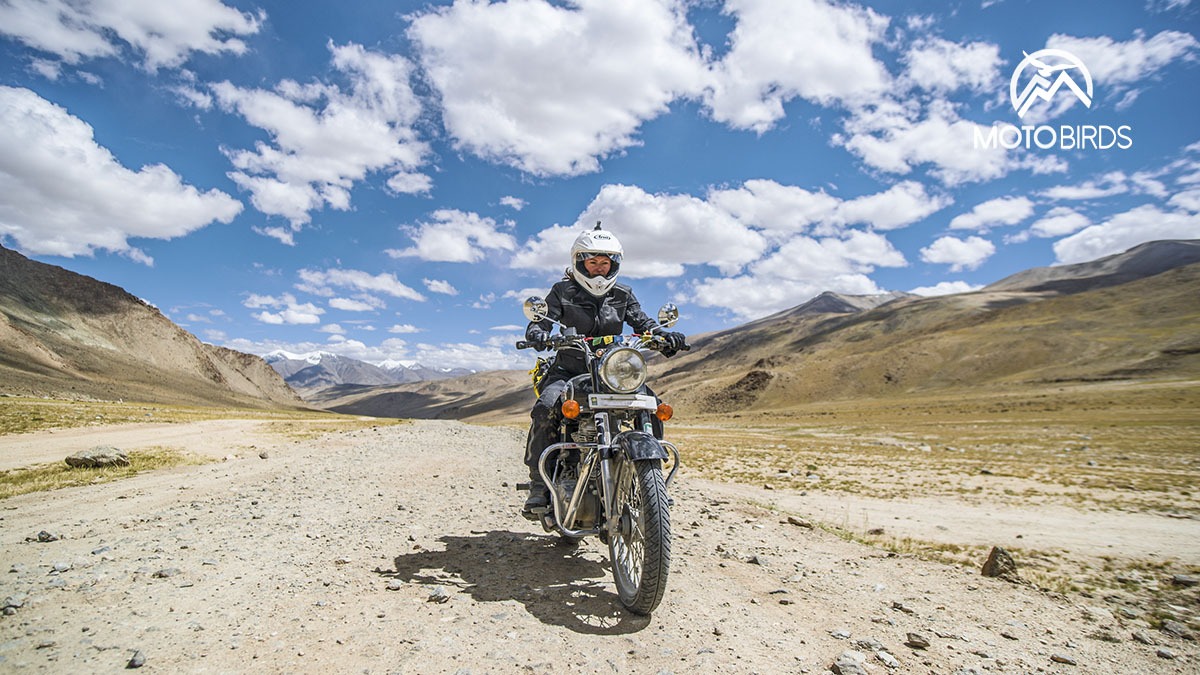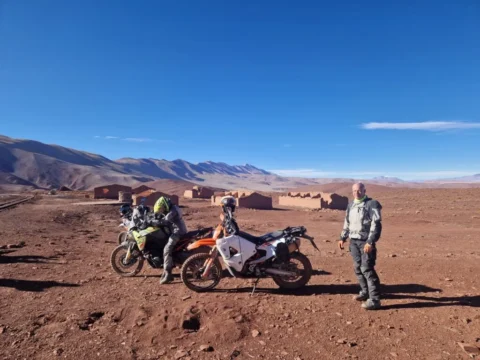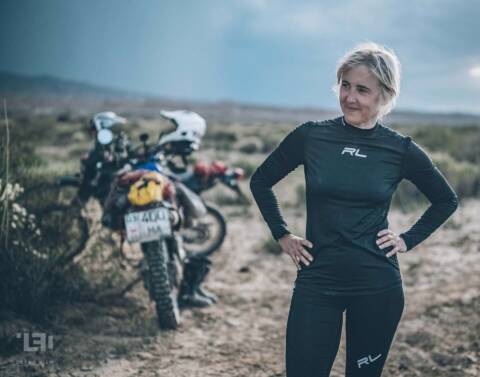WOMEN-ONLY, MOTORBIKES AND HIMALAYAS – HOW IT ALL BEGAN…
“This is way too hard.” “Nothing will come of it.” “You won’t be able to put a team together.” “You can’t do it.” Such were some of the reactions to the idea of organizing a women-only motorcycle expedition to the Himalayas. Aleksandra Trzaskowska, the originator of the project of women’s motorcycle expeditions “Tylko dla Orlic” did not let herself be discouraged: “It will all work out,” she kept saying with conviction; “You have no idea what girls can do.” Aleksandra threw a few feelers among her motorcyclist friends: the interest was overwhelming: a team of female bikers was quickly assembled. Interestingly, the concept even proved to be so popular that the need arose to even make two groups, instead of the one originally planned!
TO REACH TO THE SKY, YOU MUST BELIEVE FIRST!
After a few weeks, the plan of the expedition “Only for Eagles” (Tylko dla Orlic in Polish) crystallised. There would be two teams, albeit following two different routes. For an entire month, the ladies would visit the most interesting and remote areas of the Indian Himalayas: Spiti, Lahaul and Ladakh, among them. They would have to face the difficult Himalayan altitude, the highest passes and unforgiving road conditions. On the route there would even be a pass over 5000 meters, but also sand, streams and plenty of unknown challenges awaiting! It was not going to be a cake walk; however, the 17 passionate lady-riders were undaunted and ready to take on that motorcycling adventure head-on.
In August 2022, after two years of an imposed “covid break” made of travel restrictions, border closures and endlessly changing arcane testing requirements, we’re finally returning to the Himalayan trails!
Why the Himalayas? Because it is one of our favourite riding regions, because adventure riding in these mountains guarantees stunning views, because it is also a spiritual journey to go so far from our usual every day life, because it allows a return to nature – a world we partially lost track of.

But, let’s get back to our main topic. Today’s write-up is about how it all started, about the project to lead a women-only motorcycle expedition to the Himalayas. On August 17, 2016 our gravel heroines set off to conquer the highest mountains in the world on classic Royal Enfield Bullet motorcycles. For us, organizers, we initially had some misgivings about the motorbike choice, being they were so different to what most are used to riding in Europe. The entire experience turned out to be one of most transformative motorcycle adventures in the history of MotoBirds & Tylko Dla Orlic…
Aleksandra Trzaskowska, recalls this memorable first Himalayan expedition…
BETWEEN US EAGLES – YOGA FOR GOOD MORNING
We typically started our day with a yoga cession. Sometimes at 6 am, sometimes 8:00am, depending on how difficult the route ahead was going to be and how many hours in the saddle that would mean. Some days though, we had to start at dawn to make sure we had ample time to overcome the more challenging road sections, five-thousand meter passes or washed-out road sections.

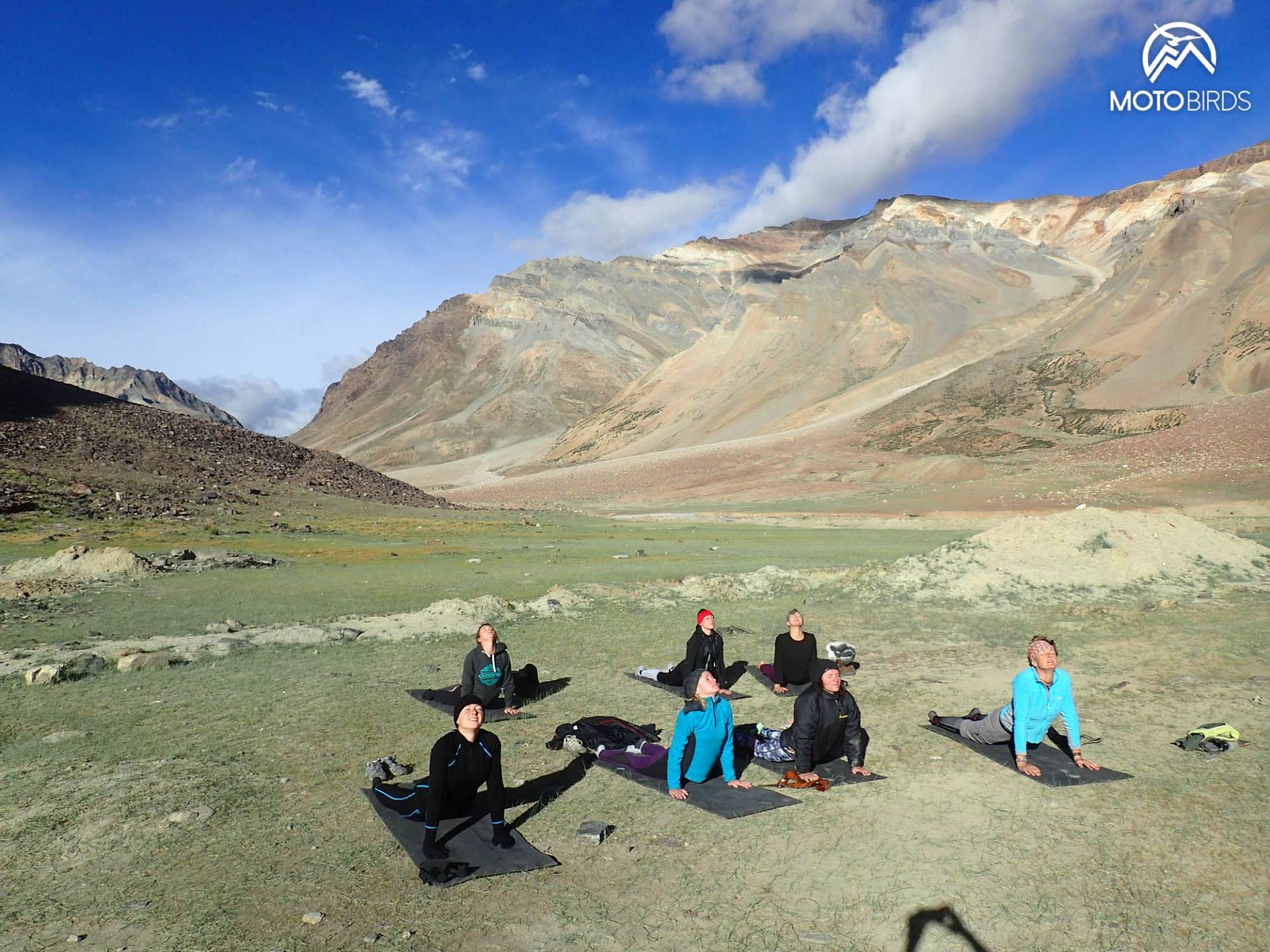
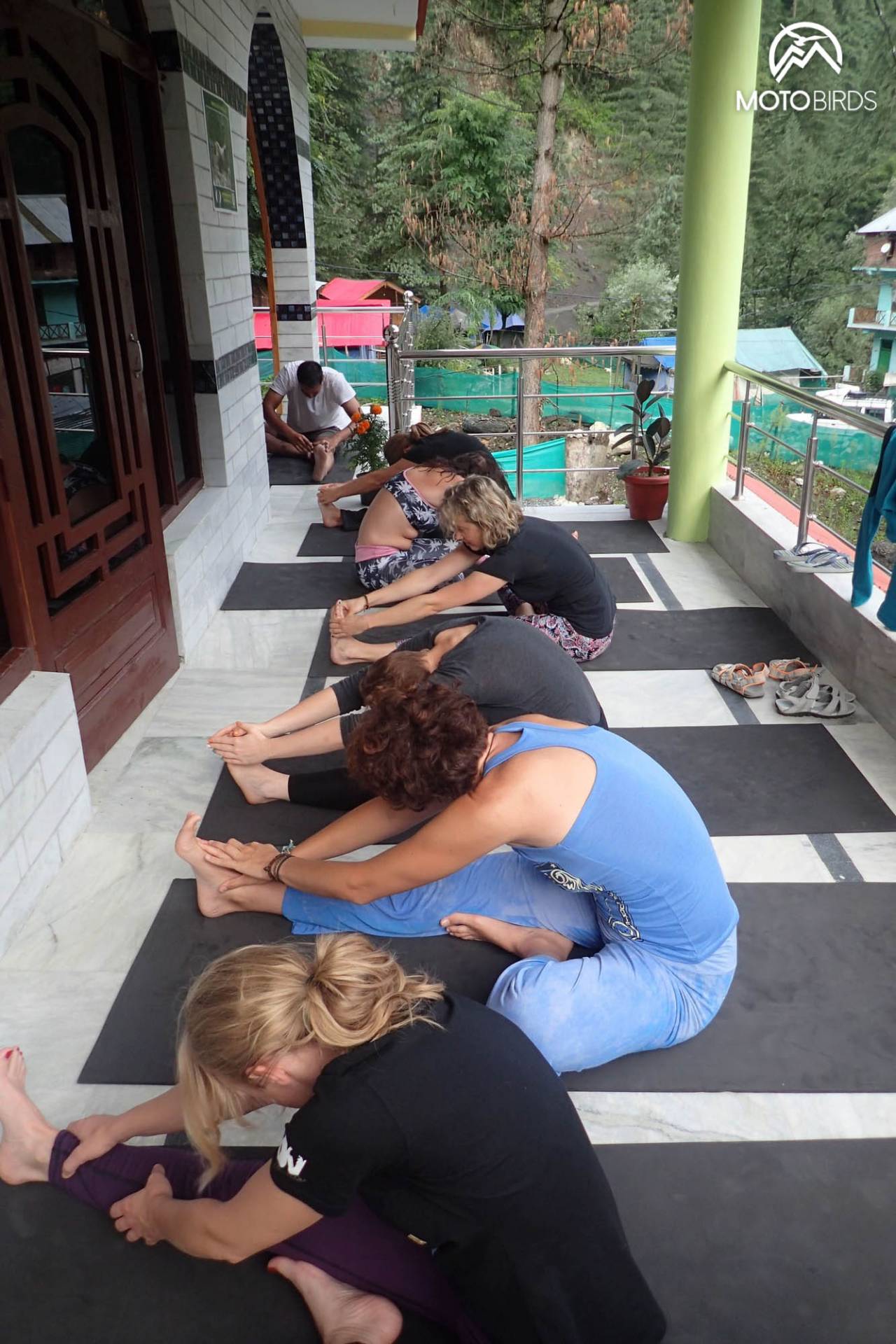
Each day, when we saddled-up, I asked myself what surprises would be ahead, how many rivers we would have to ford today, would the road be passable, are would we reach our destination before dark…
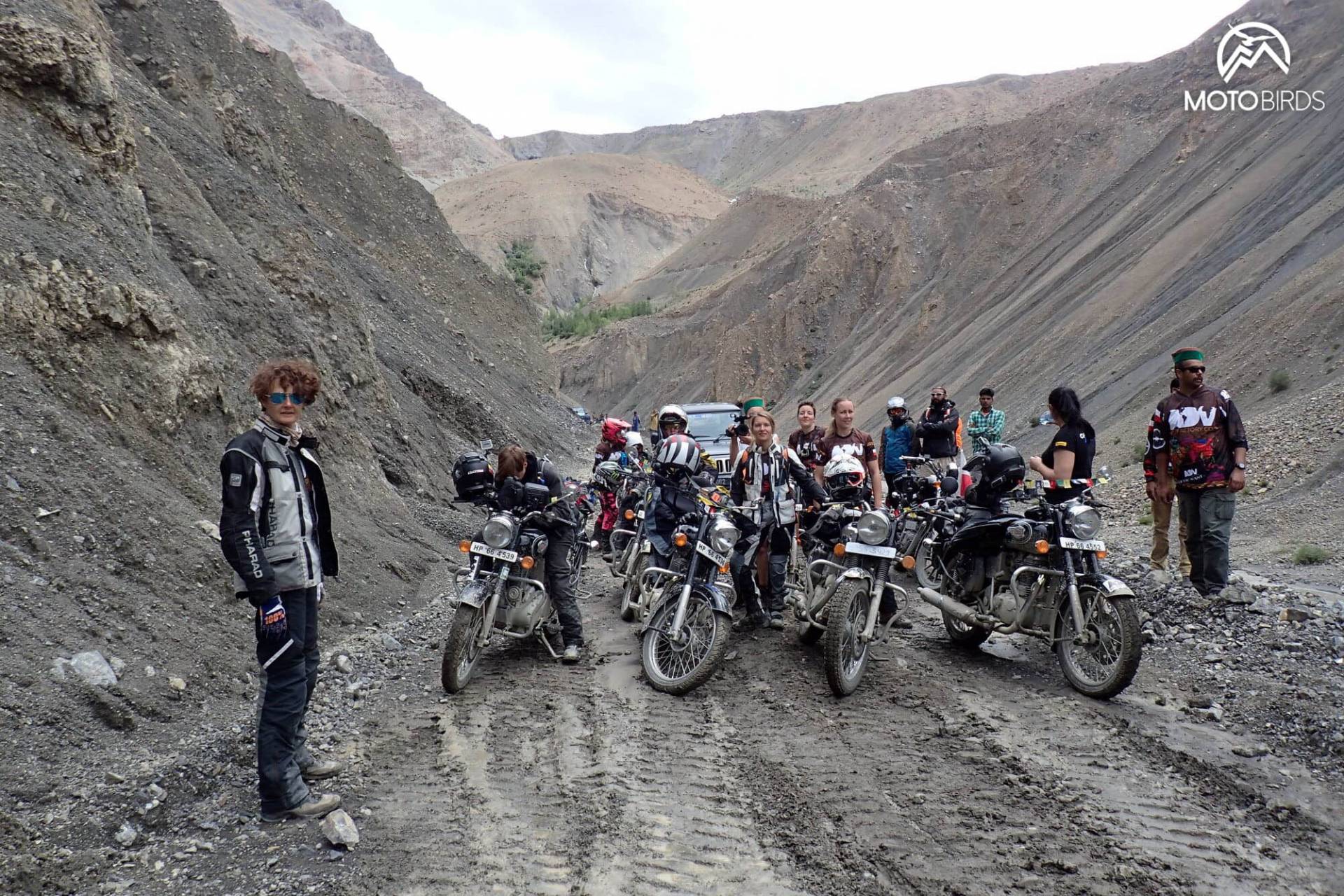

My anxiety was compounded by a recent major landslide which reportedly totally blocked our route. I decided there was no point to continue and we stayed over a second day in the same pension – hoping things would get resolved. But how would we make up for this lost time?
Yes, landslides happen all the time in the Himalayas, but it’s difficult to convey to the group that some oriental patience will help make the most of the circumstances. Sometimes, the landslides are small and cleared in a matter of hours. Other times, it may take days. The Indian army’s BRO arm thankfully has heavy equipment at the ready for such events – most times.
On the main road from Manali to the capital of Ladakh – Leh, in the summer months, there is constant traffic. However, along smaller roads, traffic can be rare and these roads are strategically less critical. Getting stuck there could be for days.
Thankfully, our motorcycle adventure had departed under a lucky star. We were stopped by one large landslide for 8 hours, which we eventually manage to overcome, as soon as the road was somewhat cleared of rubble. Other landslides were smaller or did not require heavy equipment to clear them.
HIMALAYAN ROADS – A LITTLE CHAOS WON’T HURT
On Himalayan roads, traffic is insignificant compared to what you’ll find in crowded Indian cities. However, the face of the cliff is never far, and you must keep your eyes peeled for speeding trucks. In particular, military convoys seem to take no prisoners on the road! Indian government statistics will tell you that on an average day, the equivalent of a jumbo jet of people die on Indian roads. However, thankfully, the Himalayas are largely spared from this. When they happen, accidents can be dramatic though…
I recall an especially difficult day. It was our last day in Spiti and Lahaul. We started at dawn. It all started with an argument with the guesthouse staff: they were unhappy with our breakfast time – and they did let us know! Other days are different; not only are we now used to our Royal Enfield motorbikes, but the left-hand traffic is now second nature to all of us. Then, there are the monasteries…
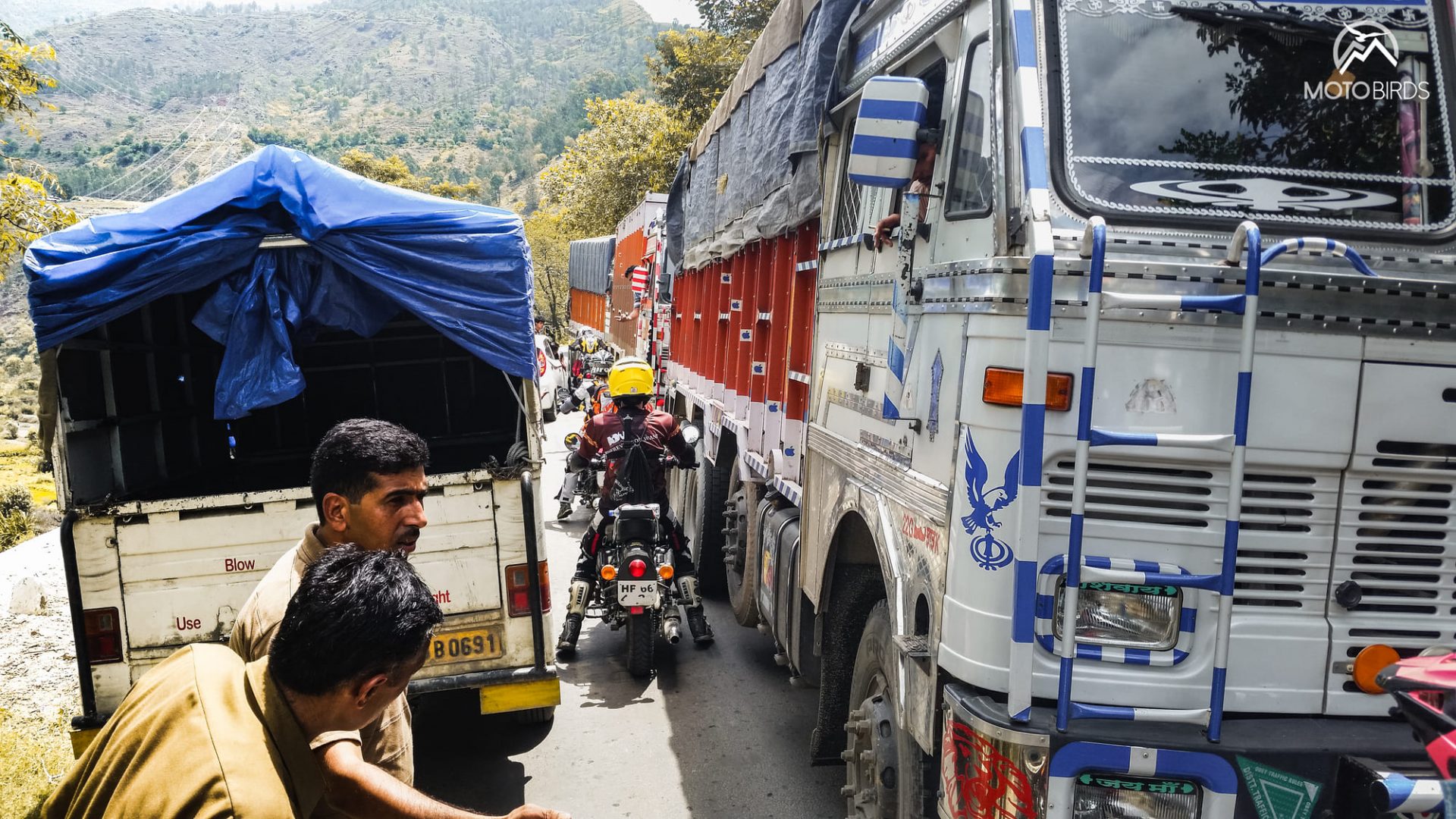
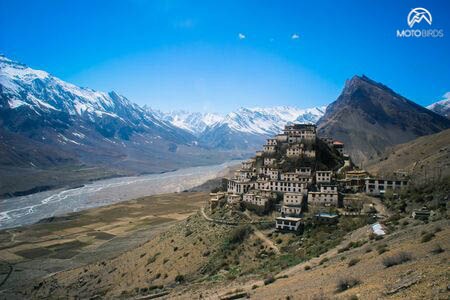
The Monastery of Key is one of the most stunning of the Himalayas. Its white walls dominate the grey-brown valleys underneath. Colourful flags with the Mantra “Om Has Ni Pad Me Hum” are everywhere. The same mantras are hung between the mirrors of our motorbikes. When we ride, they flap in the wind like the wings of colorful birds, hopefully protecting us and bringing us luck in our journey.
OM MA NI PAD ME HUM
Getting close to Buddhist culture was for me inseparable of that first expedition. The culmination was an impromptu visit to a nun temple in a small town monastery in the vicinity of Keylong. The nuns were pretty easy going, if I compare them to some of those of my native Poland. That monastery is located at the end of a narrow road. We had to leave our bikes in the village nearby, and continue on foot along that narrow path. Our visit surprised them enormously. They typically had little contact with the outside world. We had brought with us a few bags of flour, dal, rice and other necessities. Despite the language and cultural barriers, we quickly manage to find ways to communicate. Not only did we share lunch with them, they also gave us our first-ever lesson of Indian cuisine!
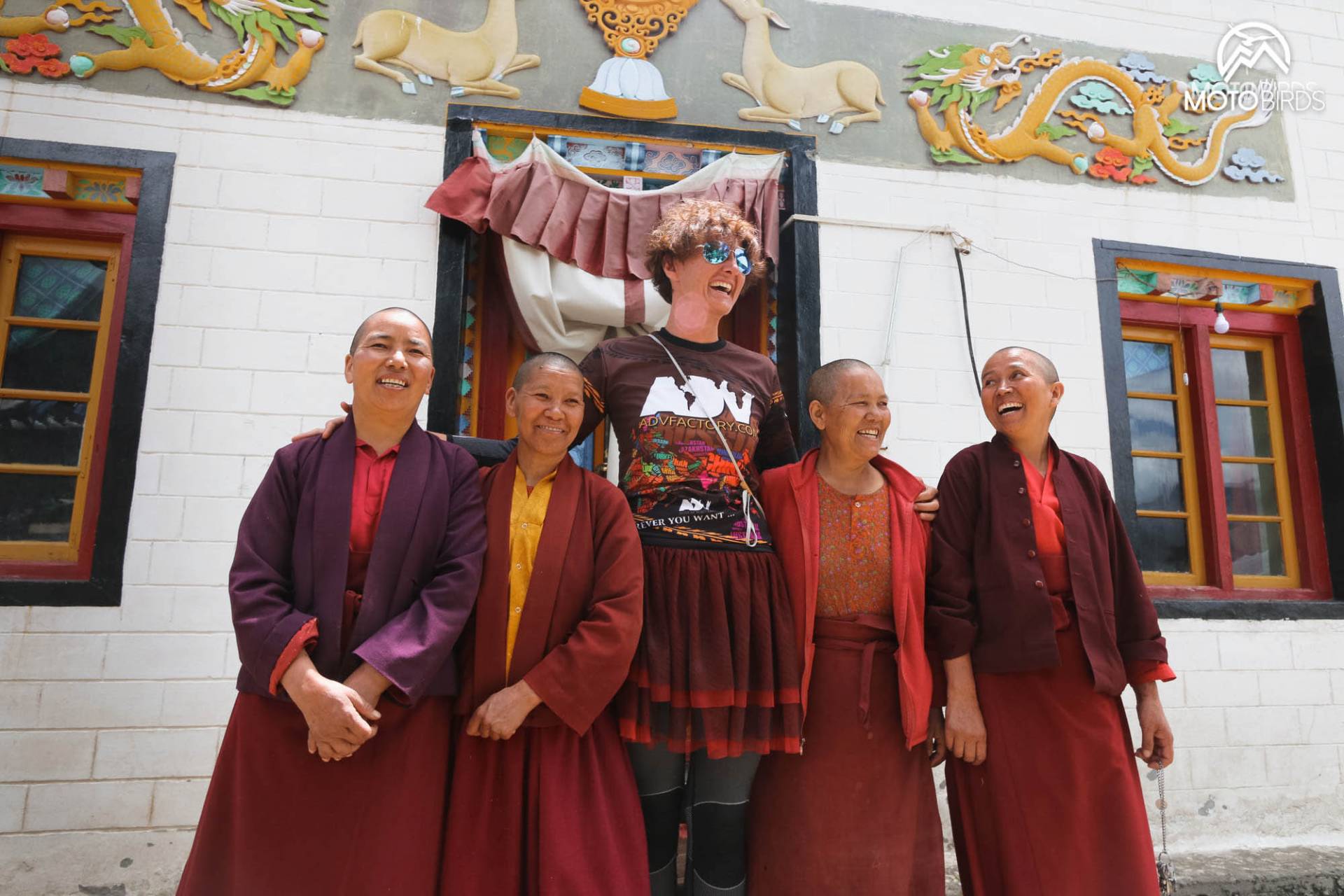
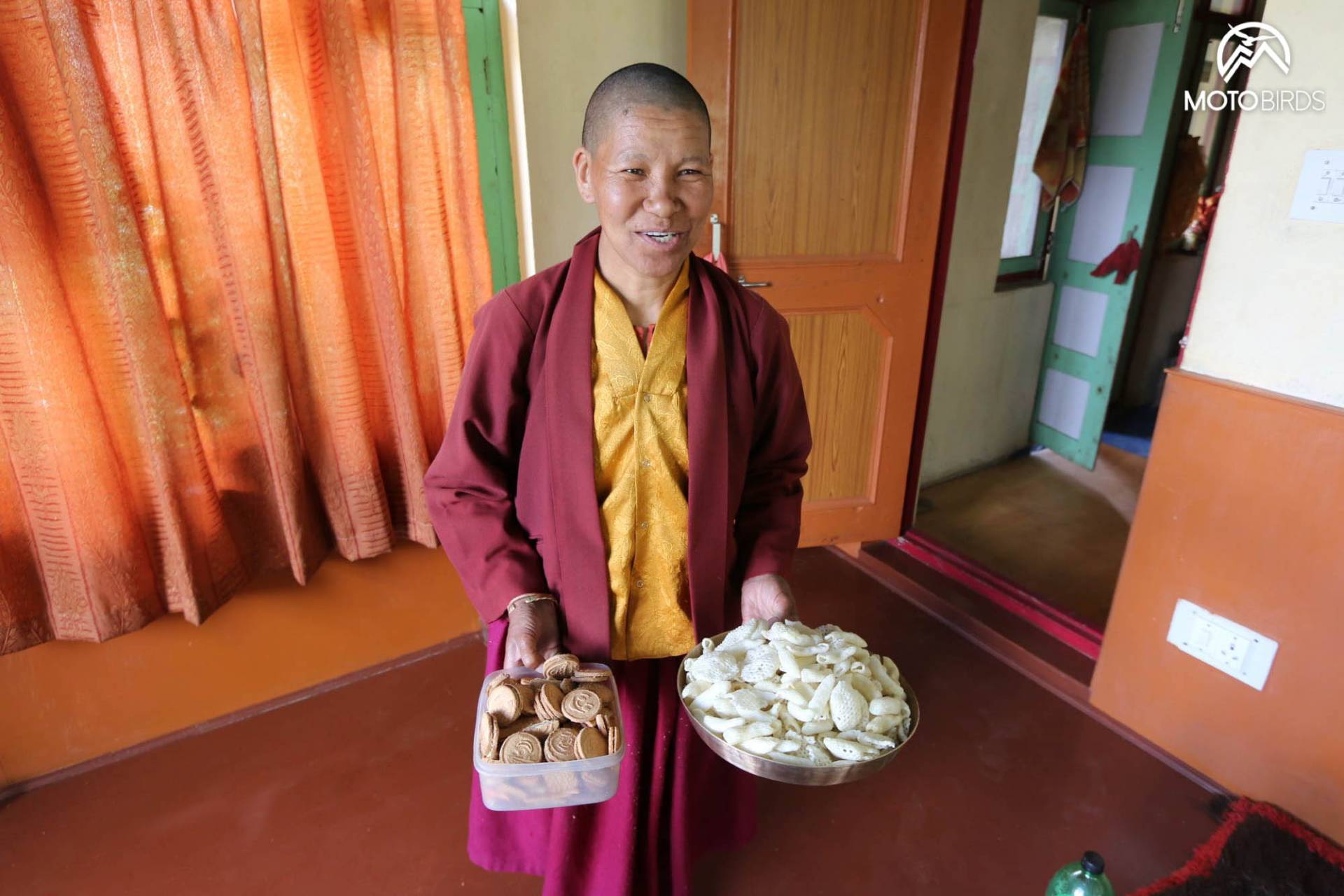
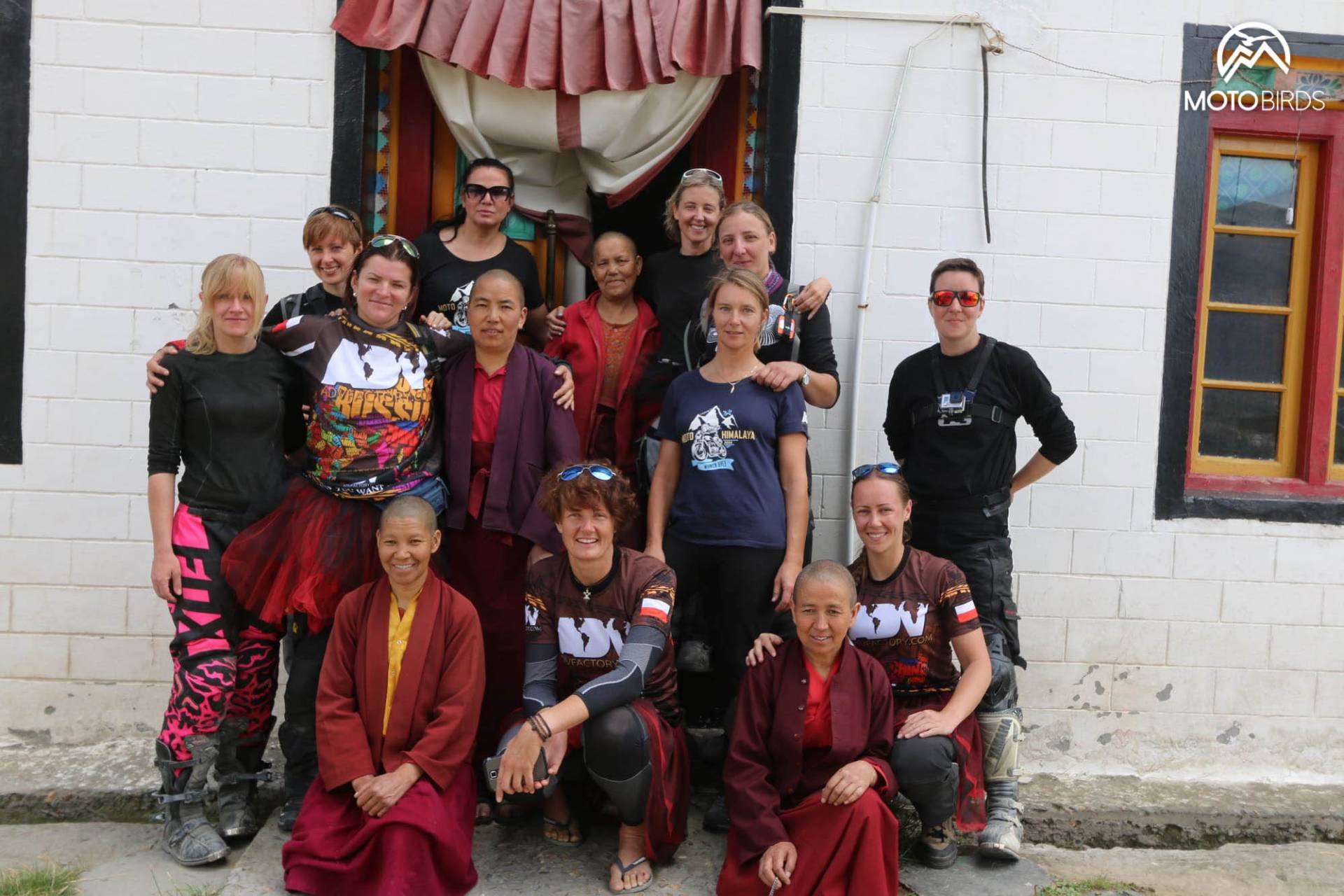
PASSES IN THE SKY
We continued our ride along long snaking valleys. The red skirts the lad bikers are wearing on top of their riding gear were flapping in the wind, catching the warm orange rays of the morning sun. Temperatures were ideal.
We felt on top of the world. Everywhere people wanted to take pictures of our team. While the endless opportunities for photographs are killing our average speed. We constantly pass herds of goats and cows, countless bridges (some still standing fortunately). The landscape around us is gradually changing as we climb higher and higher. Do we take it slow or give ourselves more time to take in the landscapes? The “go-slow” option thankfully won. Did we really fly to the end of the world to stick to a strict schedule and constantly hurry?
Our next challenge came in the shape of a police station. In India, bureaucracy (maybe it was inherited from the British Empire) revolves around papers, signatures, stamps and permits. As our route takes us to the border areas, we are no exception: permits are required. These permits can be a test of endurance, as travelers are given the opportunity to get acquainted with the various offices. Along this journey, a precious stamp or authorization always seems to be missing. All this takes time, but is never stressful or unfriendly. These are just rules, which happen to be wrapped around various layers of bureaucracy. After a few hours of fun & games between various desks, counters and even more officers, we have our precious permits in hand!
After the permit checkpoint, starts the long climb to Kunzum La. Until now, the highest passes we rode were “only” in the 4,000 range. Incredible as it may seem, none of the challenges on that road dent the enthusiasm of our team. Be it river crossings, sandy sections, small falls. None of this is a problem for the “eagles” team! When obstacles presented themselves, they were overcome as a team. This is fortunate, because Kunzum La pass is not only high, but the road conditions can be unpredictable. A few of us had headaches and experienced some dizziness. Thankfully it did not snow or rain that day!
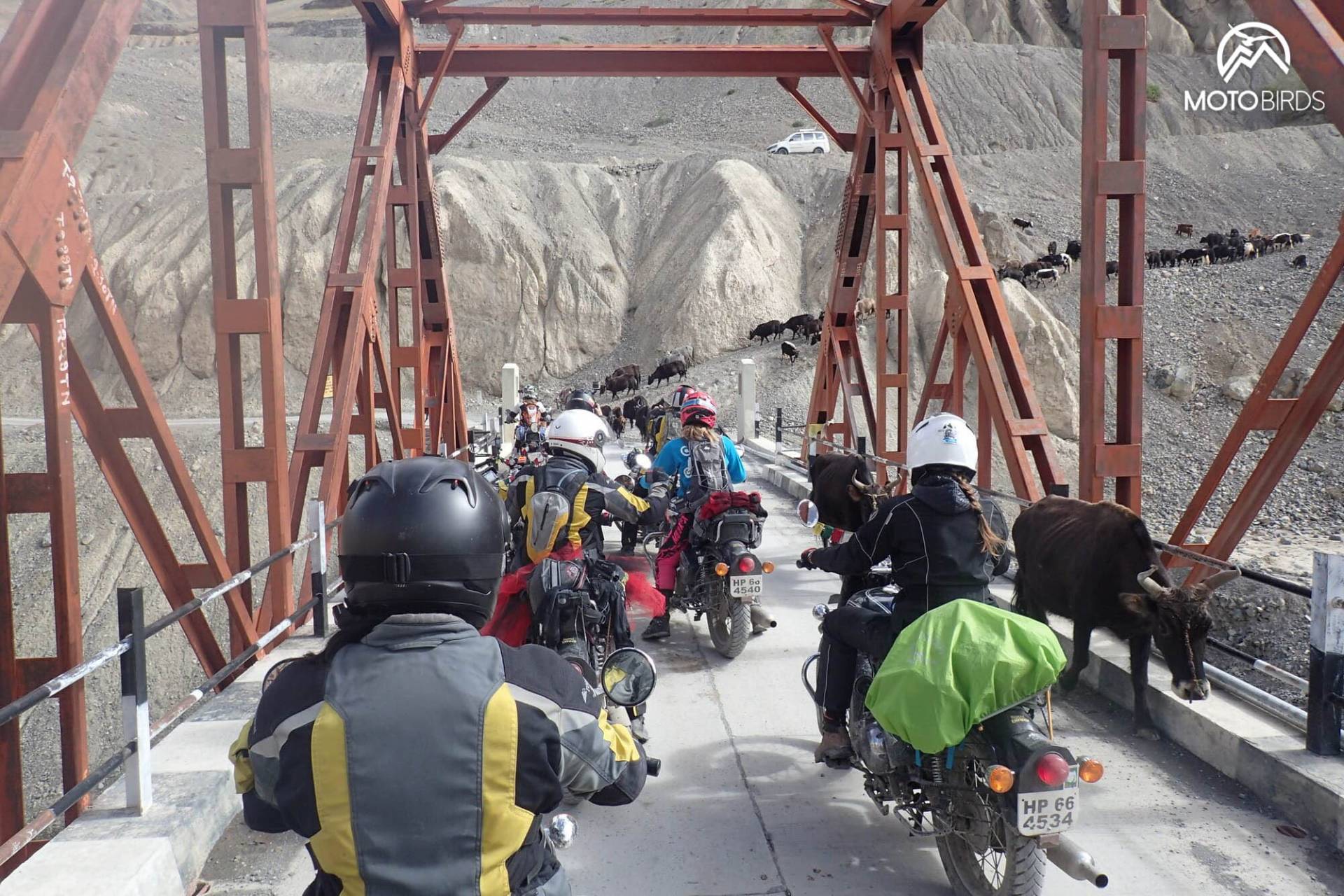
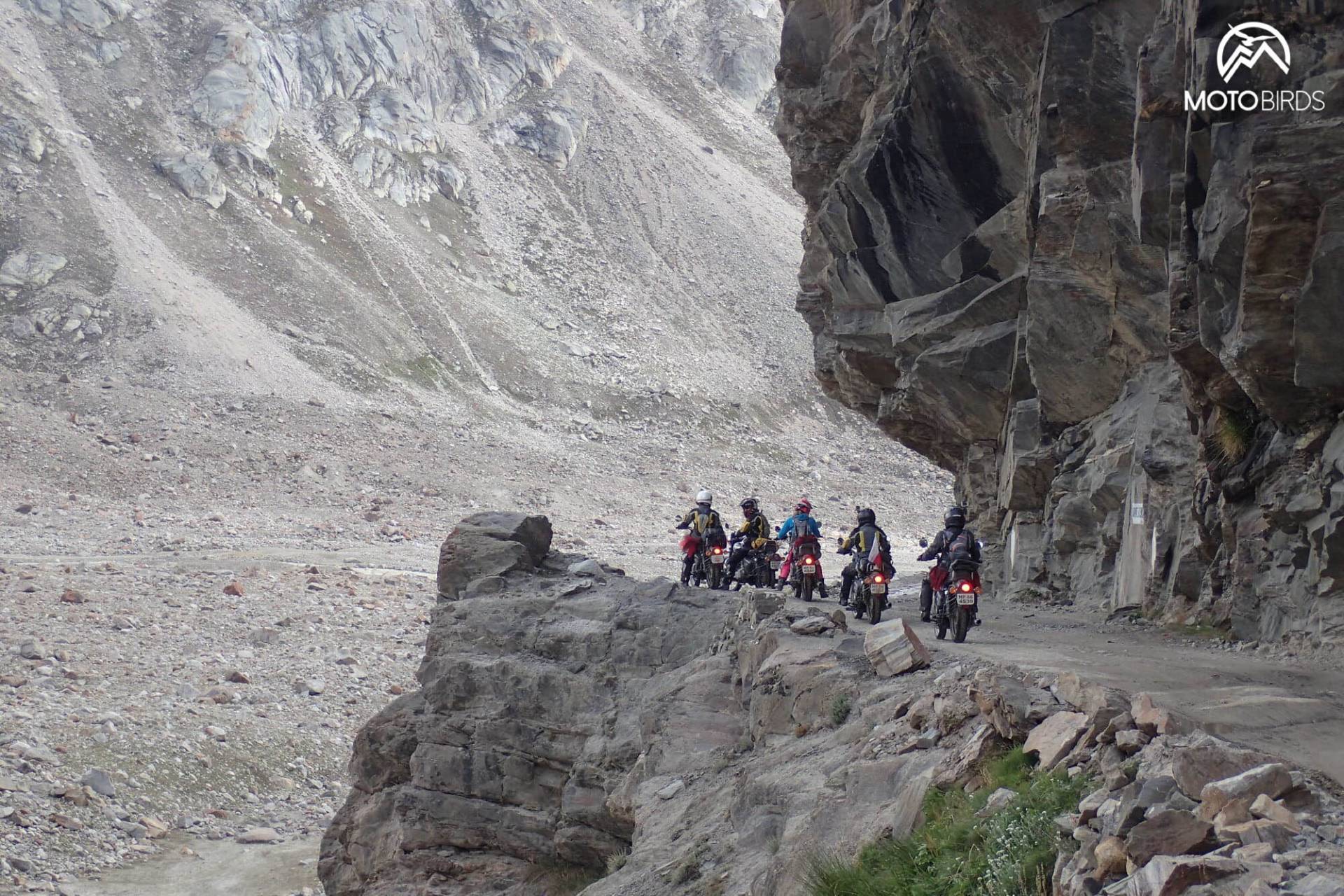
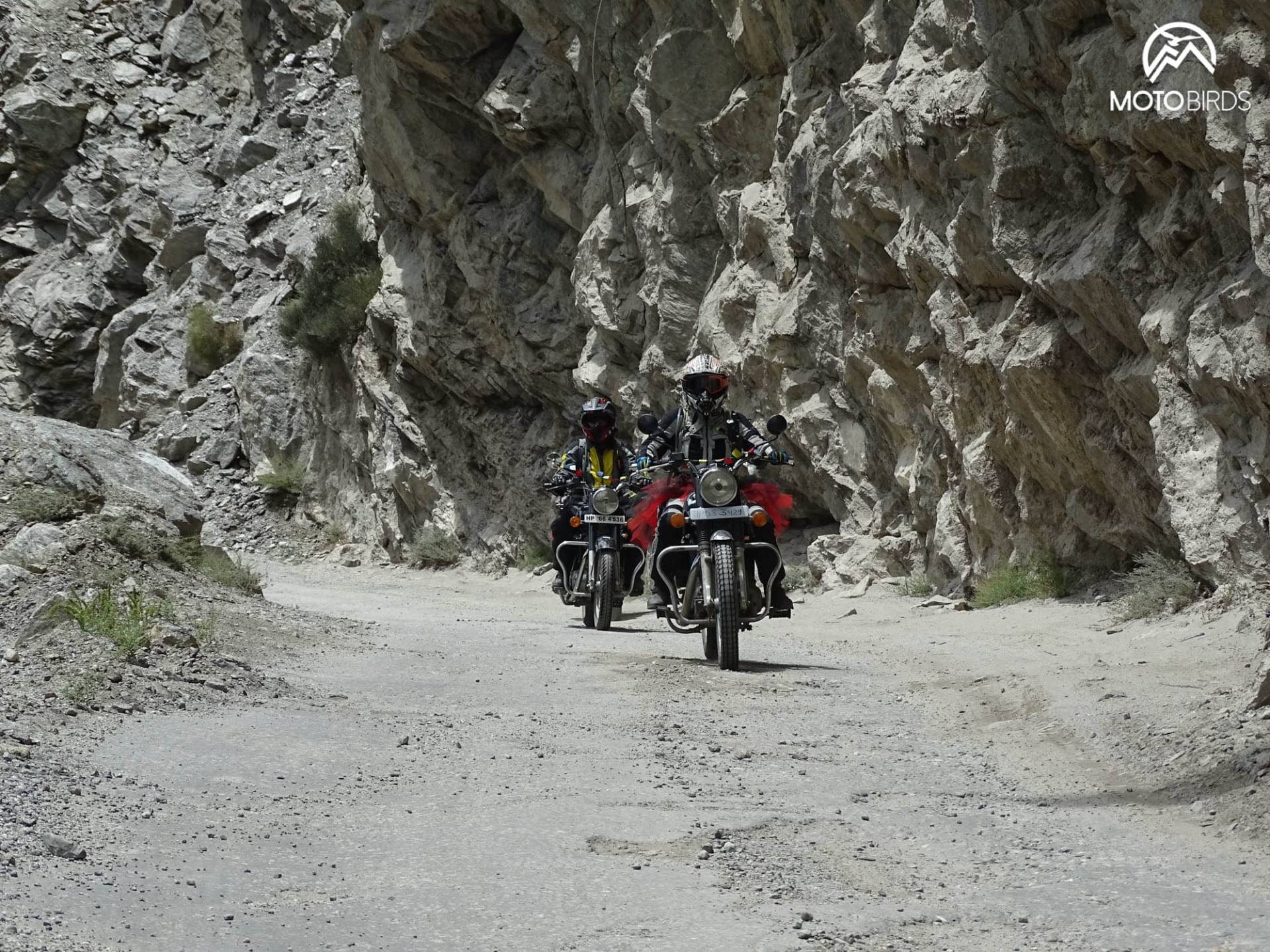
Kunzum La is not only a serious altitude test. The other difficulties can be brought along by the weather. Of course, there was a headache or sleep problems, but nothing to write home about. No one was hurt, and a few of the girls even managed to pull off athletic feats of strength, on top of the pass: pushups, squats and dances! If you’ve ever been at such altitude, you’ll know how hard it can be to catch your breath! Nothing seemed to be too difficult for the Eagles anymore!
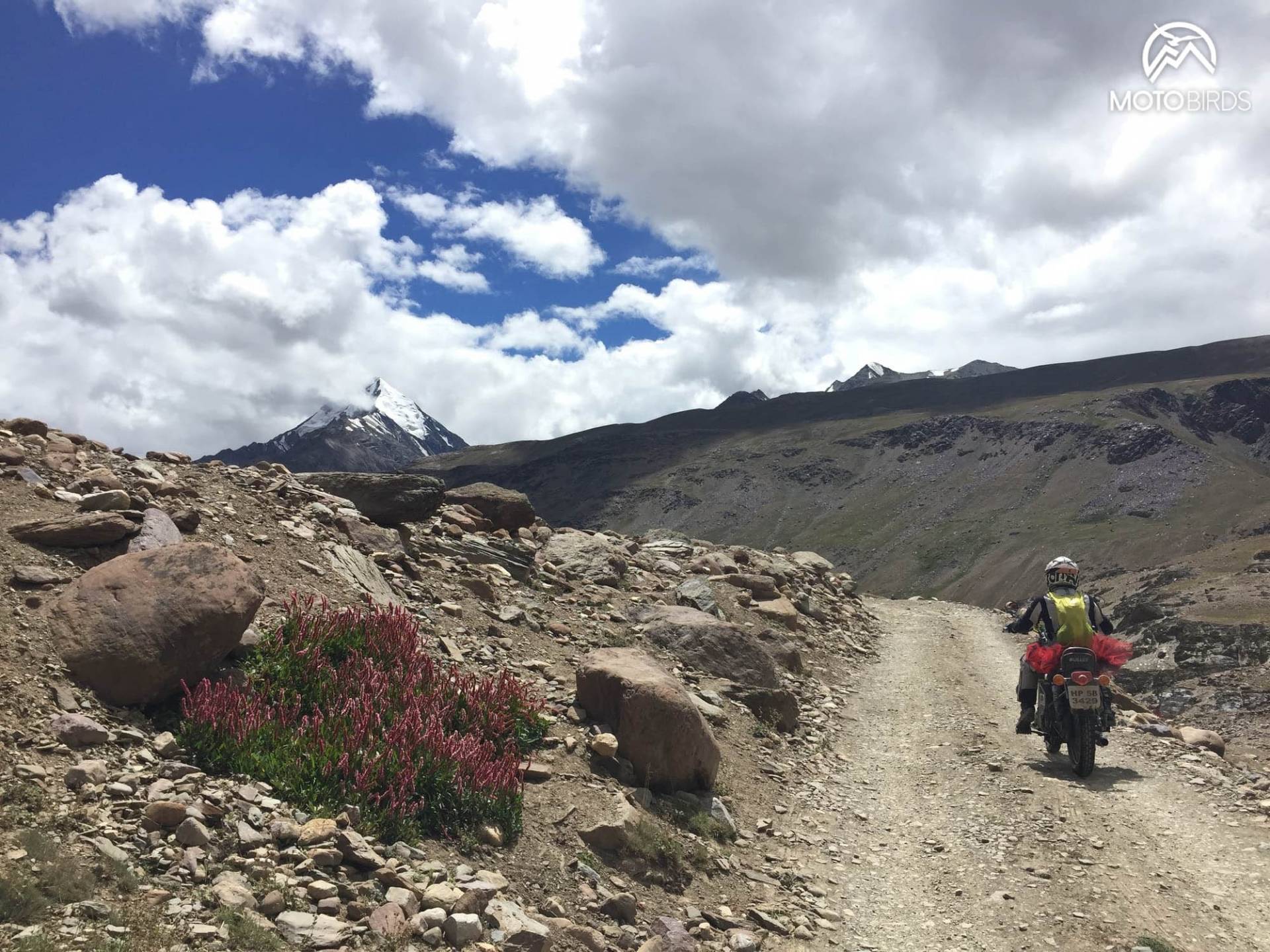
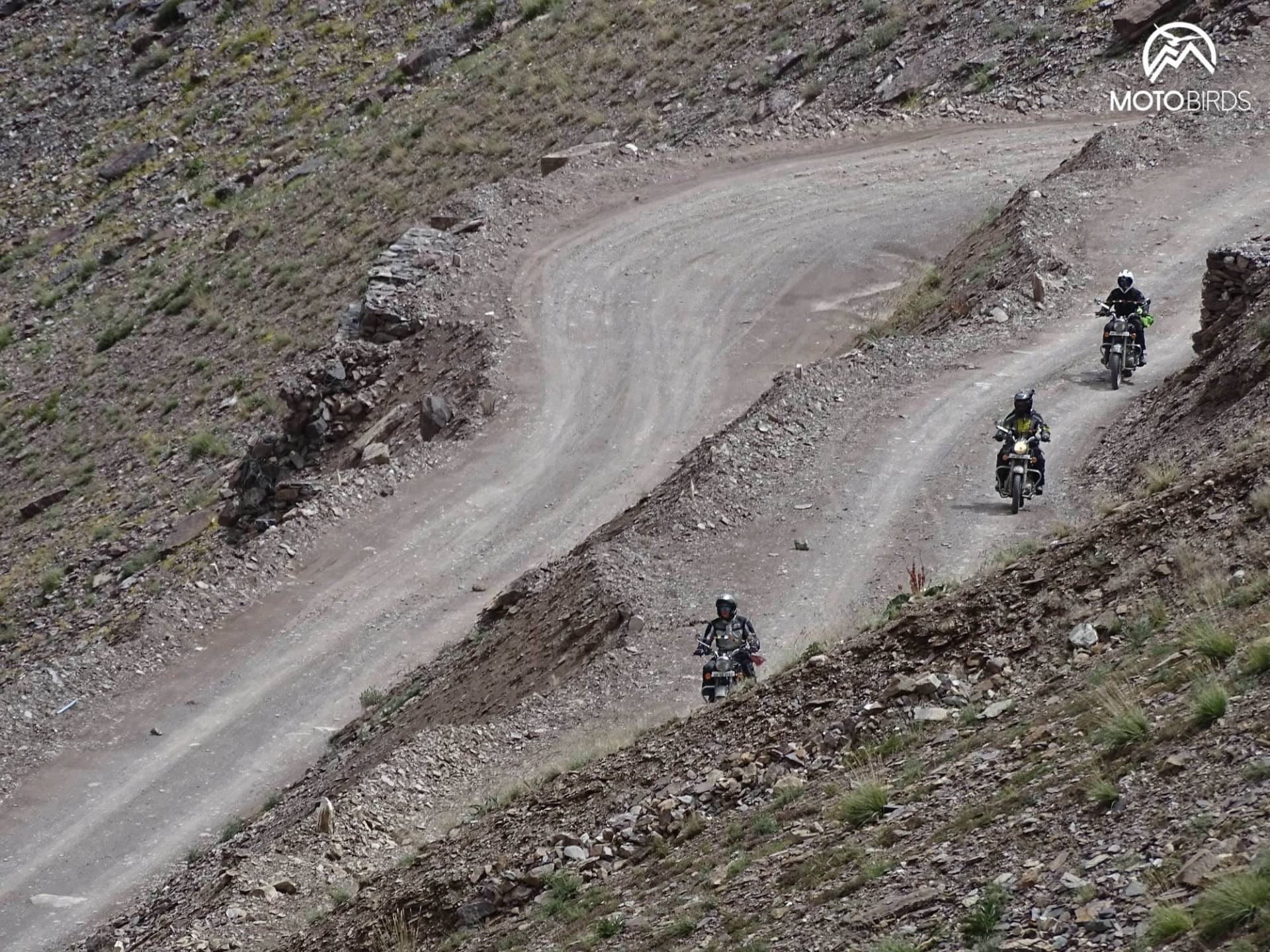
EMERALD LAKE
Crossing the Kunzum La pass among the colourful flags of the summit warranted a small celebration. However, an even more interesting highlight was just ahead. The emerald waters of the sacred Chander Tal lake.

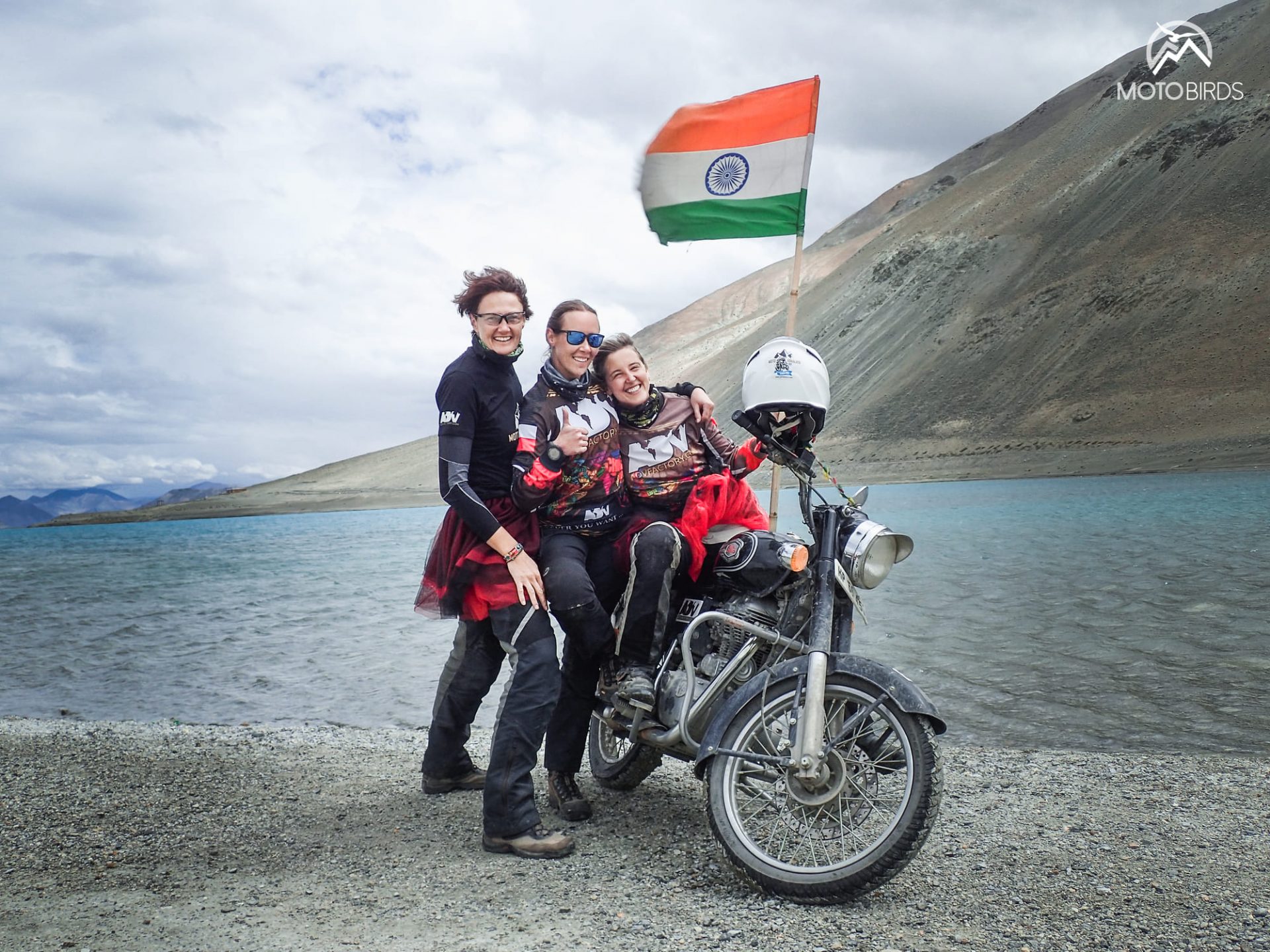
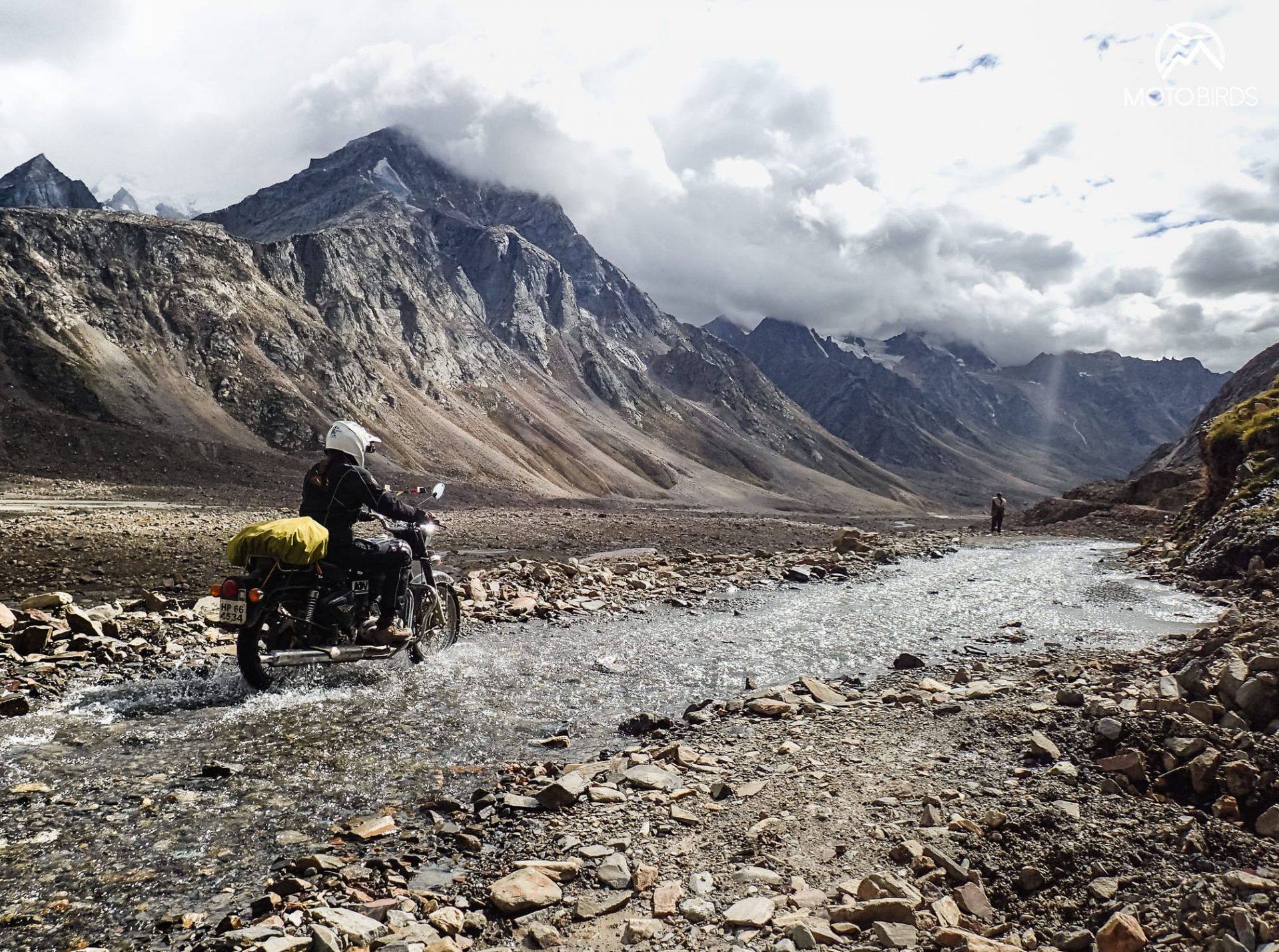
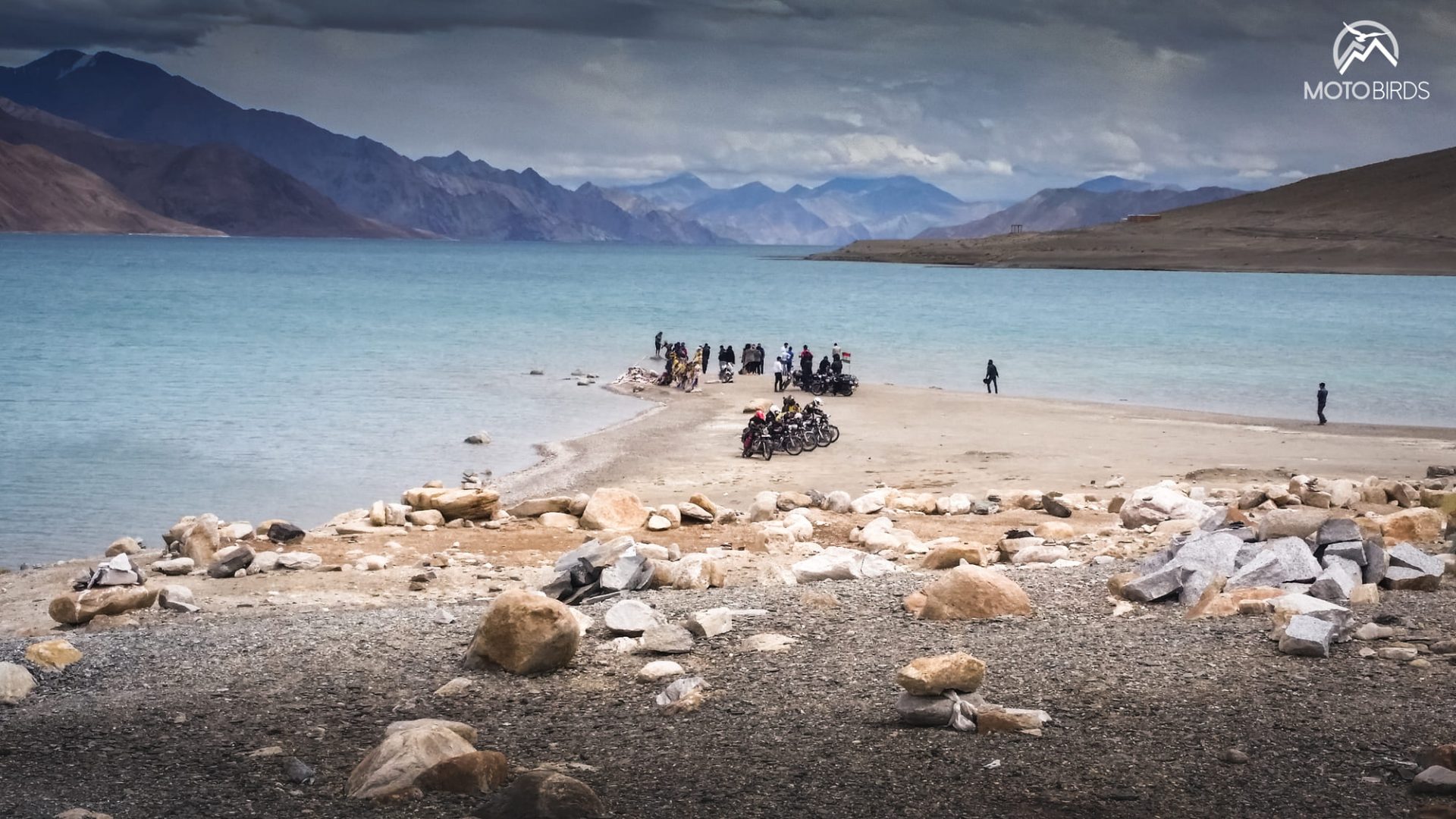
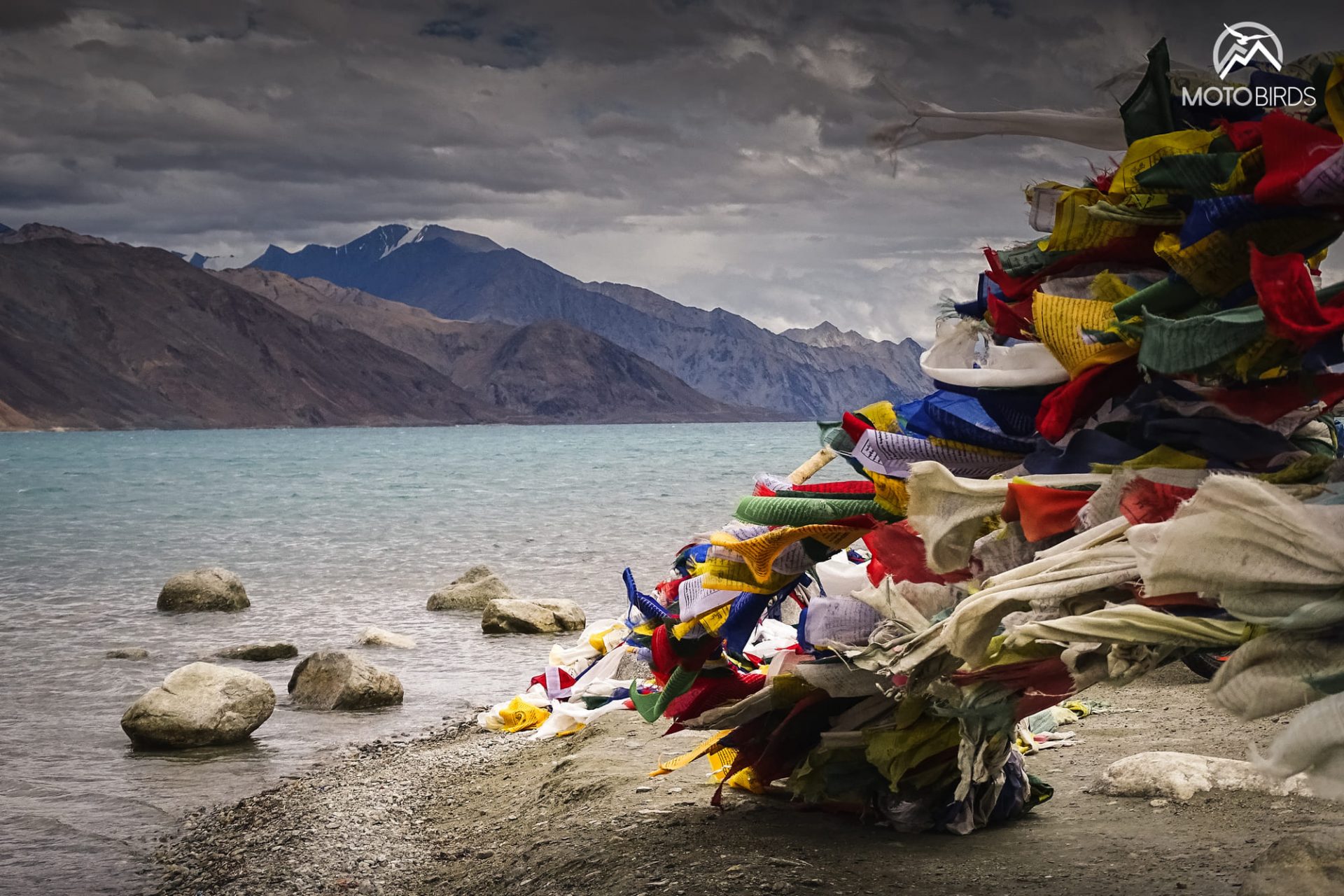
Several kilometers of narrow road later, in several places crossed by fast rivers we have to ford are only a foretaste of what awaits us. The second part of our journey was going to be where the proverbial rubber meets the road. Which ones of us were real dirt stars?
Working as a team, we reached the lake! You could only hear silence, as each and every one of us was lost in their thoughts, admiring the deep emerald-colored waters of Chander Tal lake.
The girls don’t know it yet, but Pangon Tso lake is still in front of us. That lake separates China and India, and was made famous by the Indian classical movie “Three idiots”. Afterwards, for a few years, the lake became a magnet for Indian tourists, wanting their pictures taken there. Fortunately for us, most of the touristic traffic ends in Spangmik, a village located a few kilometers away from the shores of the lake. We’re relieved to leave the touristic areas behind us.
WE ARE GOING TO HELP
We’re also on a mission: bring some school supplies and toys to kids at isolated schools. Some are in difficult situations: far from most outside help – and with very limited resources. There isn’t enough money around to give all these kids an equal chance, despite the efforts of the government, local authorities or NGOs.
I explained earlier that there were two groups of bikers on this expedition. The first group moved towards Merak, which is the last village allowed for foreigners. During the first hours, we did not see a soul on our road. But it turned out to be a blessing: this stretch of road happened to be one of the most stunning of this expedition. The track snaked between lakes, rivers, colorful rock formations… All this at altitudes of 4,400m in glorious sunshine. What more would anyone wish for? In preparation for the sand dunes of the Nubra valley, we managed to ride our bikes on sandy beaches by one the lakes we cross. It was an exceptional day.
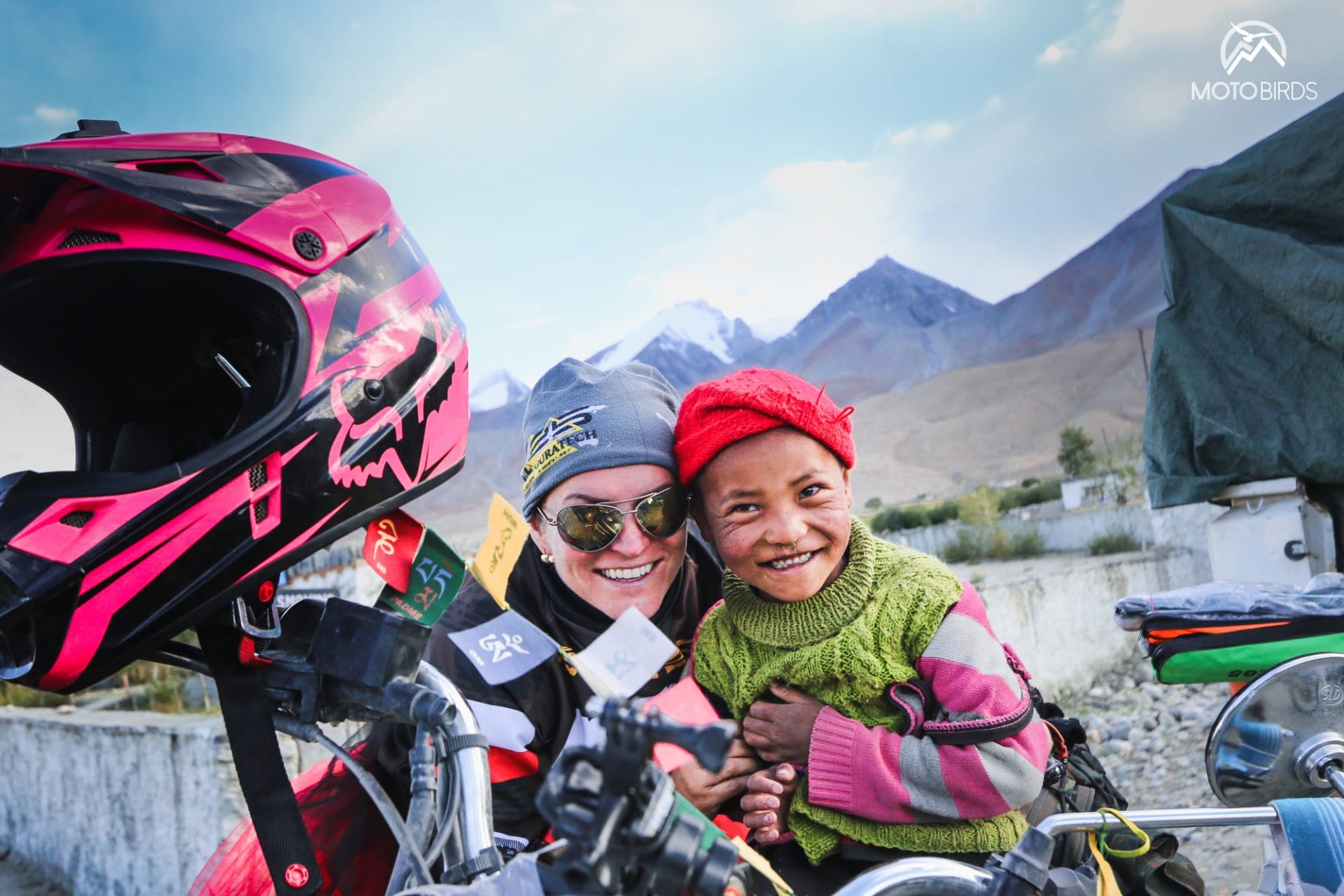
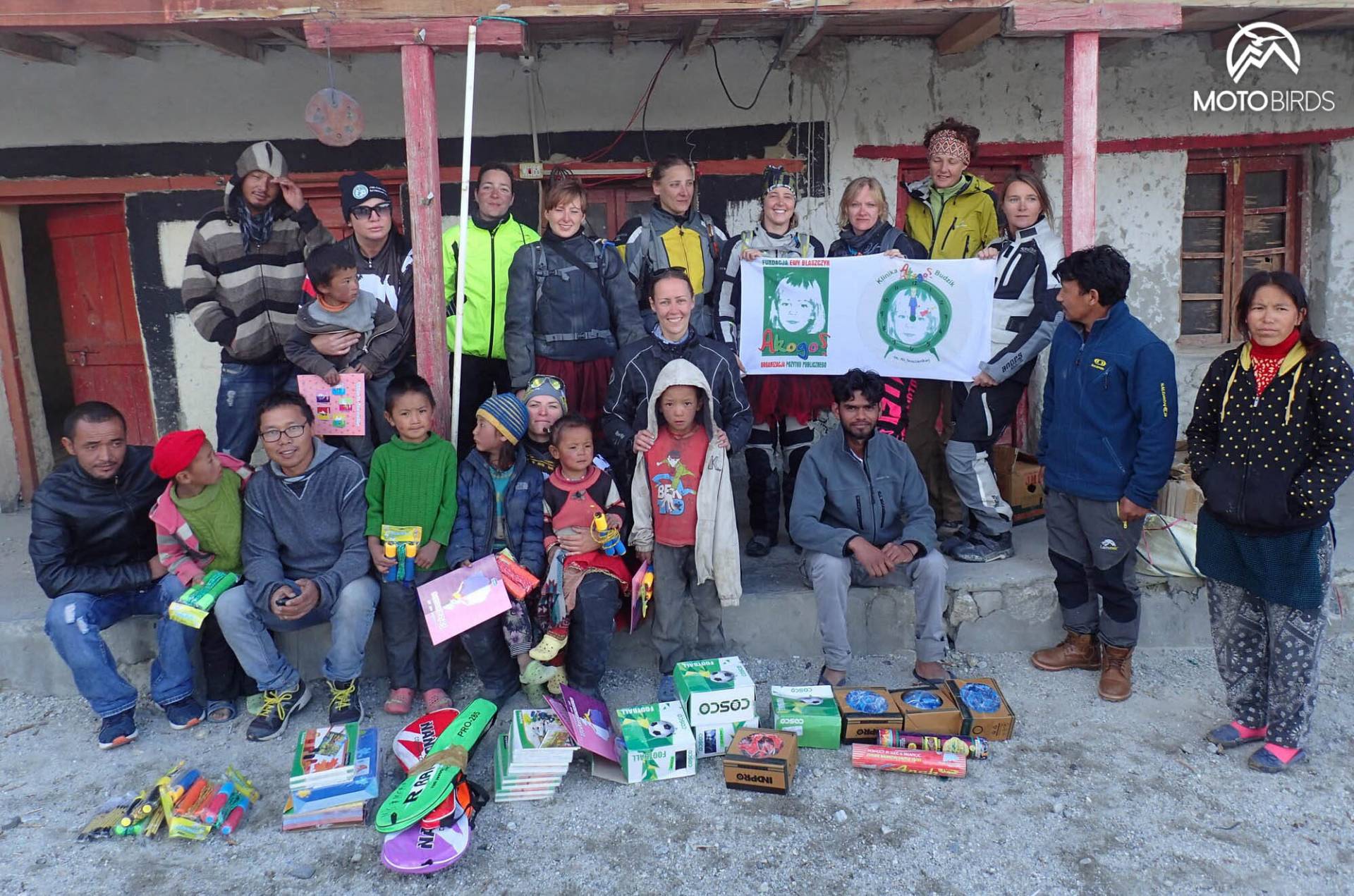
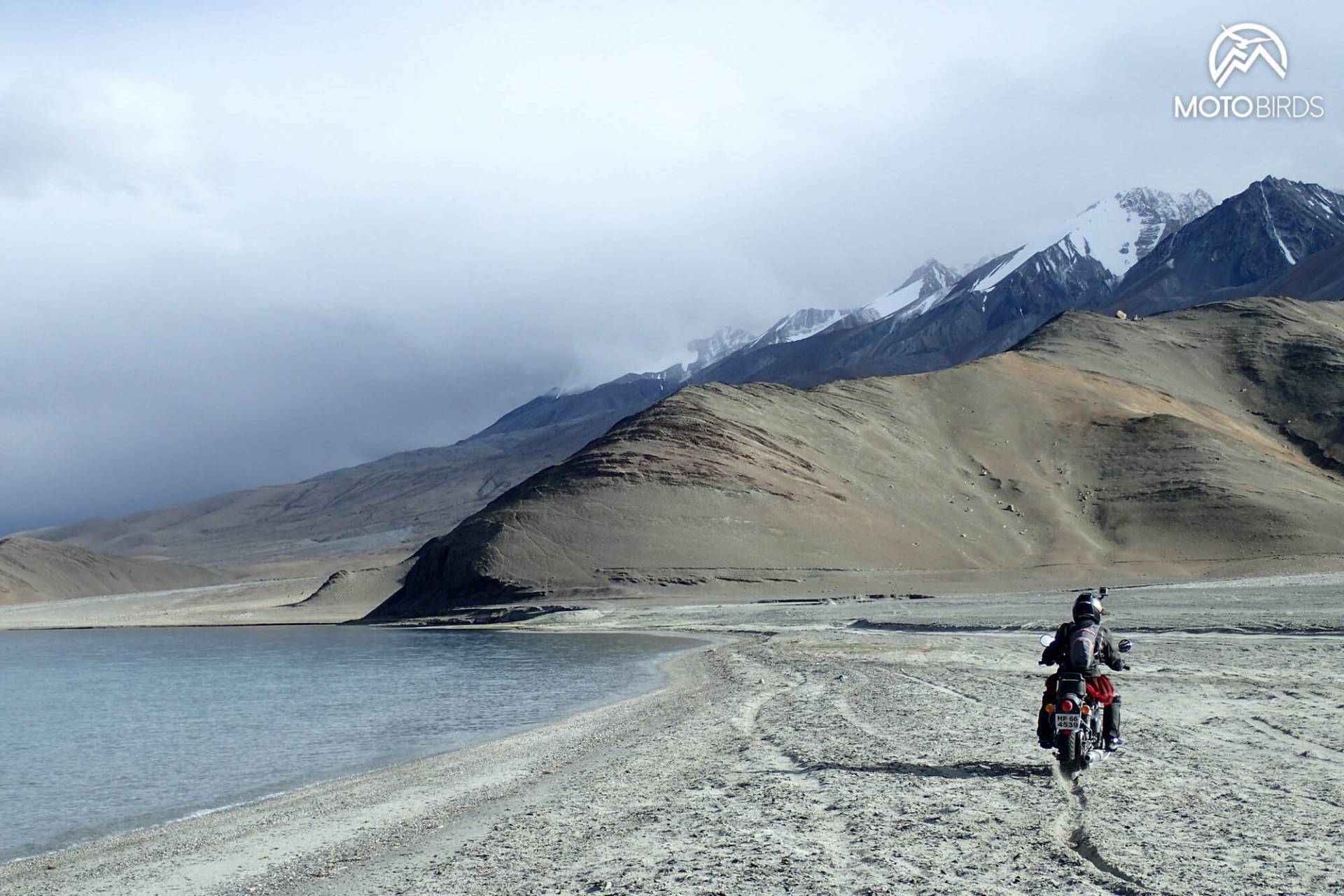
In Merak, we manage to locate the school. It was already the end of classes, and the kids had gone home for the day. Fortunately, we stumbled across a teacher. He called on the kids to come back. It was not too difficult though. The village only had a few houses – if anybody had an argument, no villager could possibly miss it. The kids eagerly grabbed their gifts, while the girls intuitively cuddle by those riders which were mothers in our team.
The second school was located on the way to Marsimek La. This village is at the opposite end of the lake. We went there with the second rider team. That school was much bigger. We could see that kids from several valleys were coming there. When we arrived, everyone was already waiting for us. The meeting was initially a bit official, but the ice quickly broke. I don’t know who was more excited about this visit: the kids or us!
CULINARY ATTRACTIONS
After returning from Chander Tal to the main road, we stopped for lunch. As every day, it is a local “dhaba”, i.e. a roadside pub in a mud hut or tent. Only local dishes are available, but invariably delicious.
I was a bit afraid of the food limitations before leaving: would girls like Indian cuisine, in a poorer Himalayan version? Won’t they get bored? Those fears were completely unfounded. Already on the third day I heard “the only thing I do not like here is the delicious food”. It is simply impossible to have any kind of diet here.
Every day, after a few hours in the saddle, we enjoyed a solid meal, consisting of at least three dishes. Breakfast was probably the weakest point of the daily diet, but everybody managed. Nobody lost weight on this adventure!
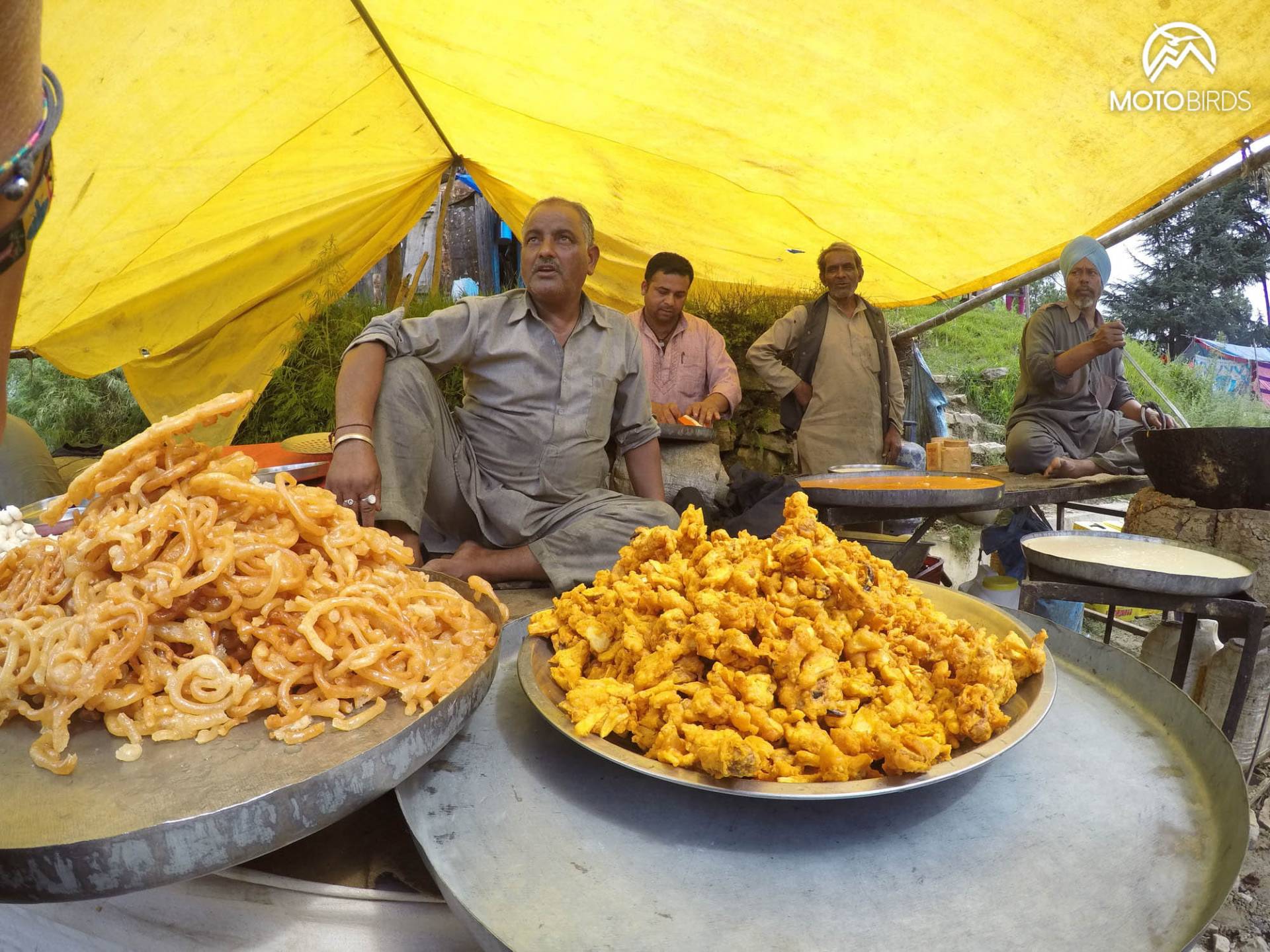
RIVERS, STORMS AND STREAMS…
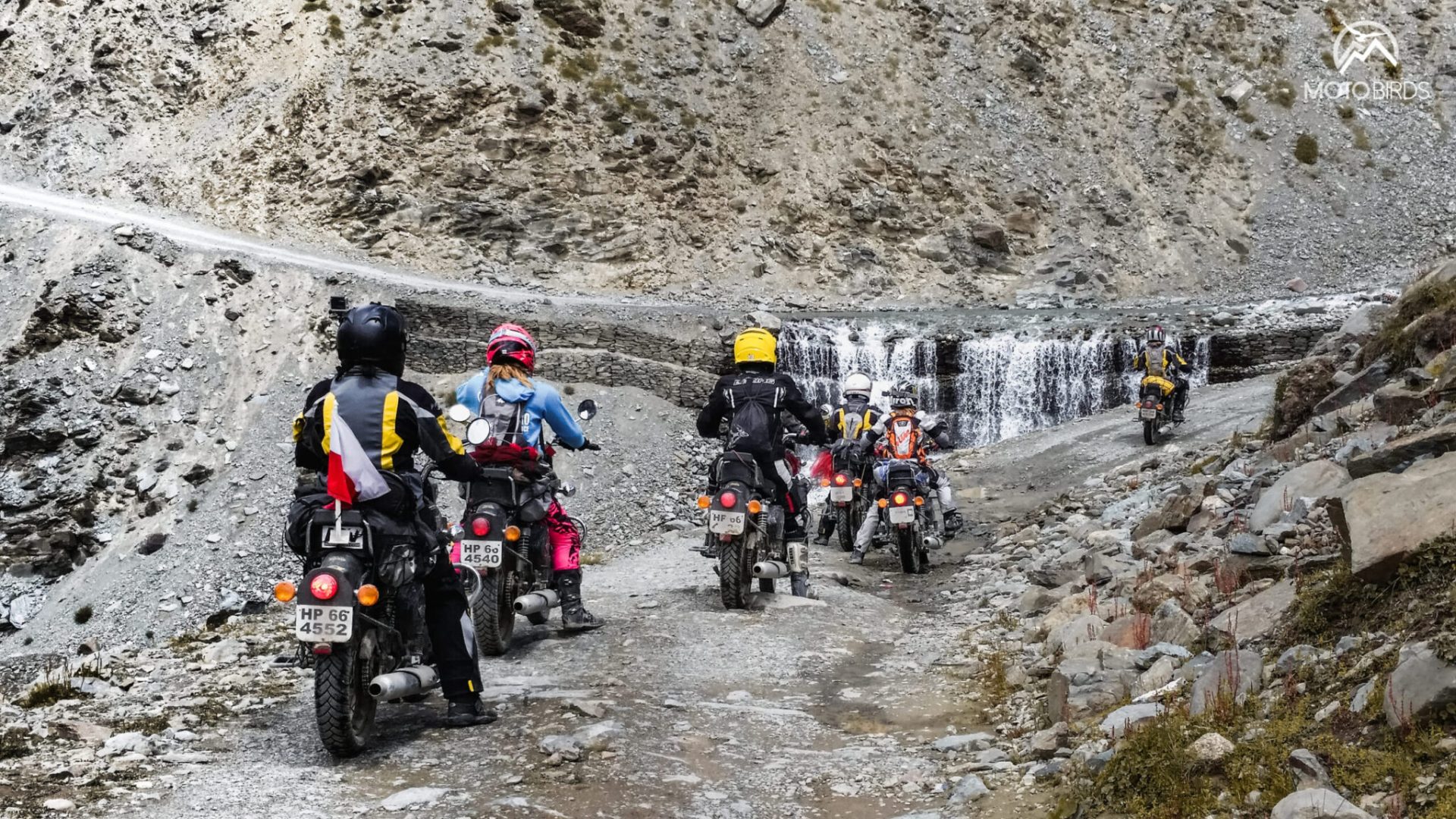

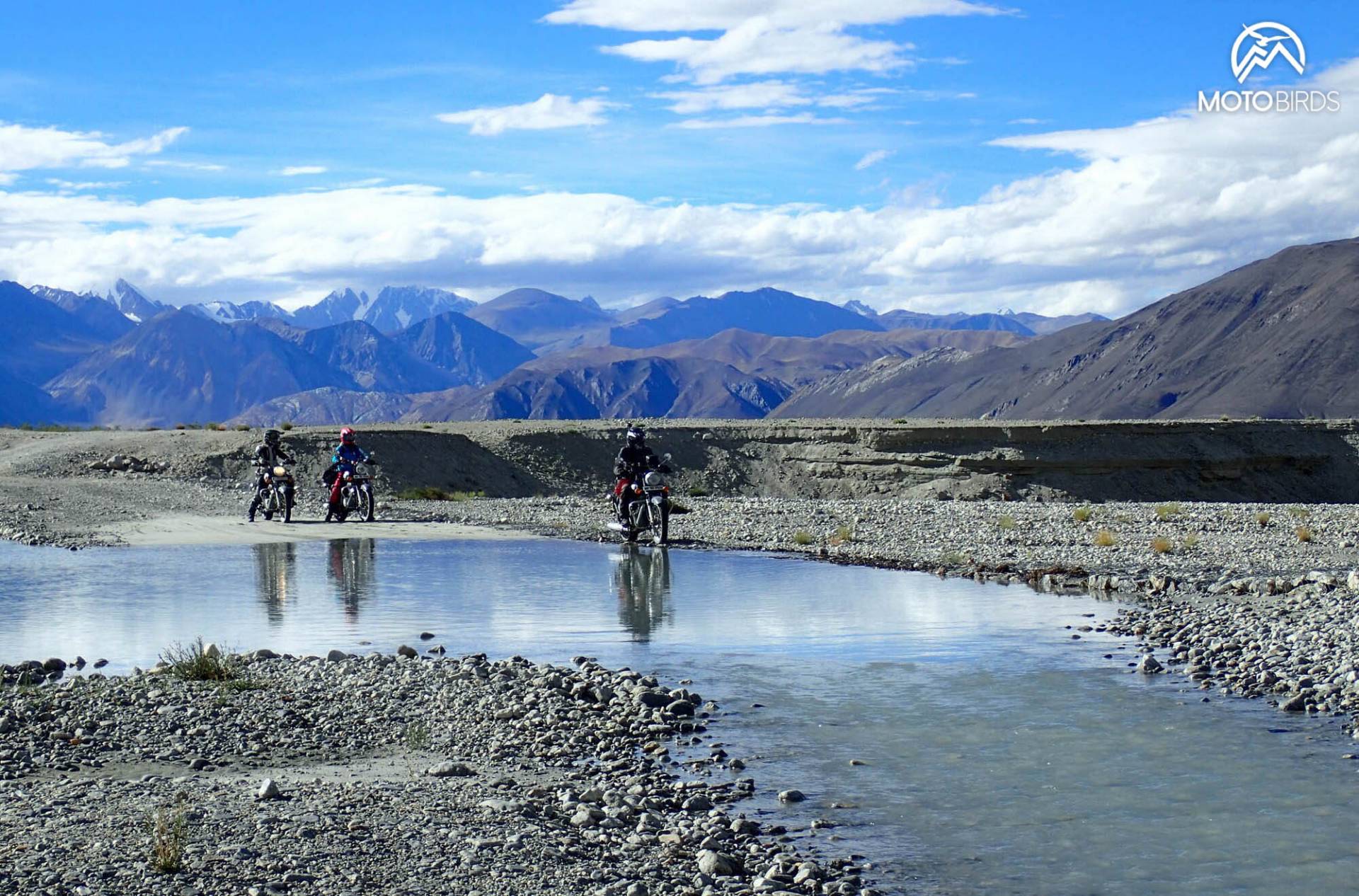
Full of hope and confidence, little did we know that the most challenging part of the route was still ahead of us… One of our riders lost a foot peg – probably it had been bent before. We managed to get a local fix somehow, but we’re not sure how long that fix will last.
We did not have to wait long for our first river crossing of the day. Then, a few kilometers further, the track was partially washed away and covered in water for several hundred meters. At least, the road base was still intact, and the water was neither too deep or too fast. We cautiously crossed, one by one. However, one of our riders hit a large rock and fell in the icy waters. The saying goes that in every river there’s somewhere a rock with your name on it. She found hers that day! So how many of these streams – and rocks with our names on them – still awaited us?
A few kilometers passed, then a small congestion appeared on the road. Traffic was practically stopped, but nevertheless several cars a day somehow managed to pass. We discovered they had been stopped by a landslide of mud and sand covering the entire road for several hundred meters. Thankfully an excavator was already at work: I communicated with the operator to lift his bucket and attempt to make some room for us to pass. He accepted and moved the machine to the side, so we could try to squeeze through. We almost got stuck in the mud, but eventually managed to move. After a good half-hour of pushing, we finally made it to the other side. The days went on like this, with obstacles to overcome – some minor, some more significant.
I remember that on the way to Pangong Tso, water flooded most of the valley, including most roads. The difficulty was compounded by the fact that most of the valley is very sandy. When wet, it all turns to mud, covered by about 50cm of water. Trucks were backed up everywhere and we had to snake through them, to slowly make our way.
Overhead, dark clouds were announcing yet more rain. We had no option but to continue the best we could. Some of us were struggling more than others. Some ladies are not tall, or not as skilled, making this section even more difficult. The local drivers we pass could not help but admire our determined group of riders!
After a few river crossings, we stopped to count them, and were all totally frozen and soaked to the bone. Those fateful 40 kilometers took us most of the day. Just as we thought we are clear and almost at our next stop, there are but a few kilometers to the main road. The entire road is cut by a waterfall! I somehow managed to pass it, but there’s no way to do this alone. We have to push the bikes across one by one, holding them from each side, so they don’t get pushed by the strong current down the cliff on the other side of what’s left of the road.
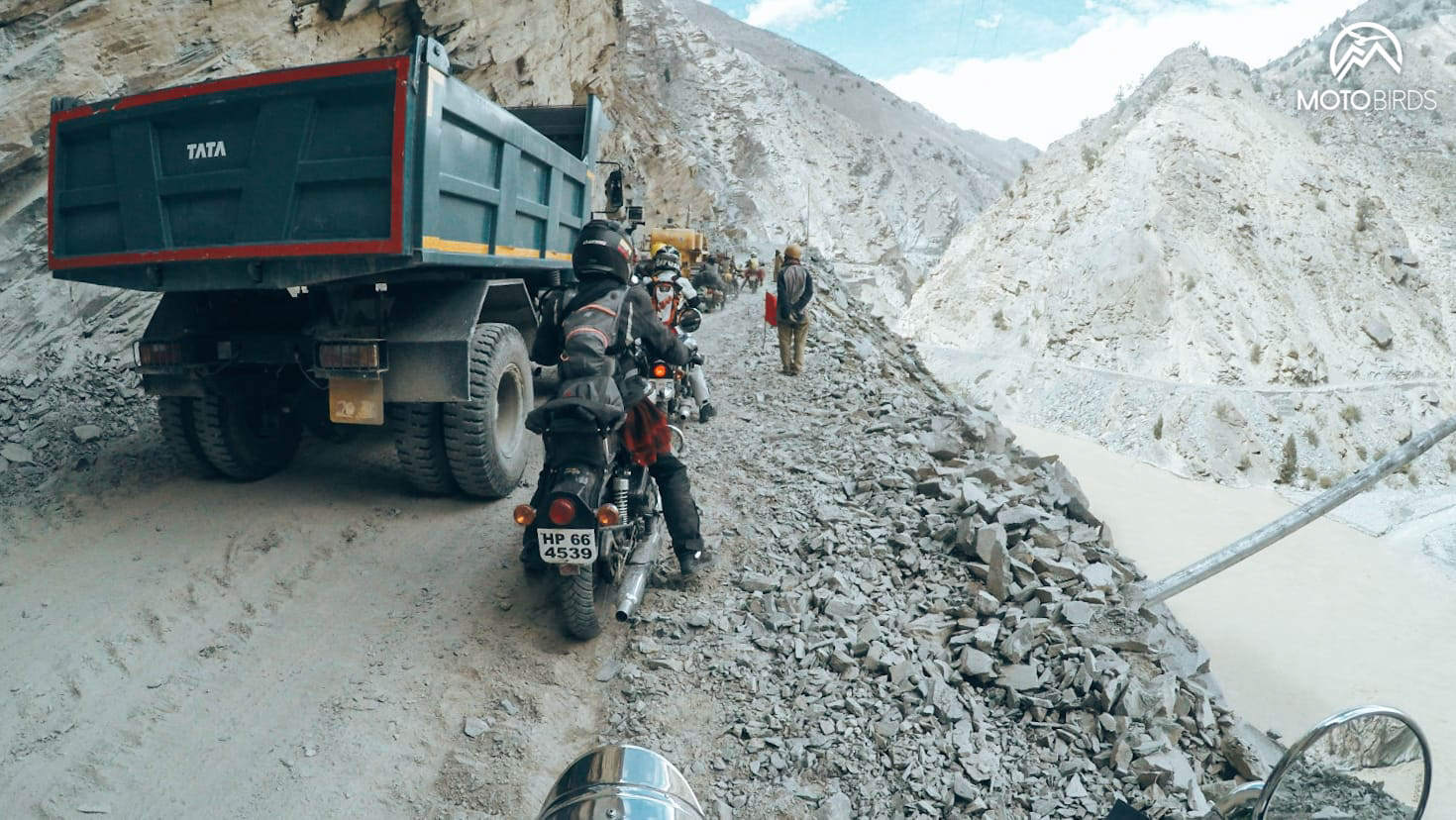
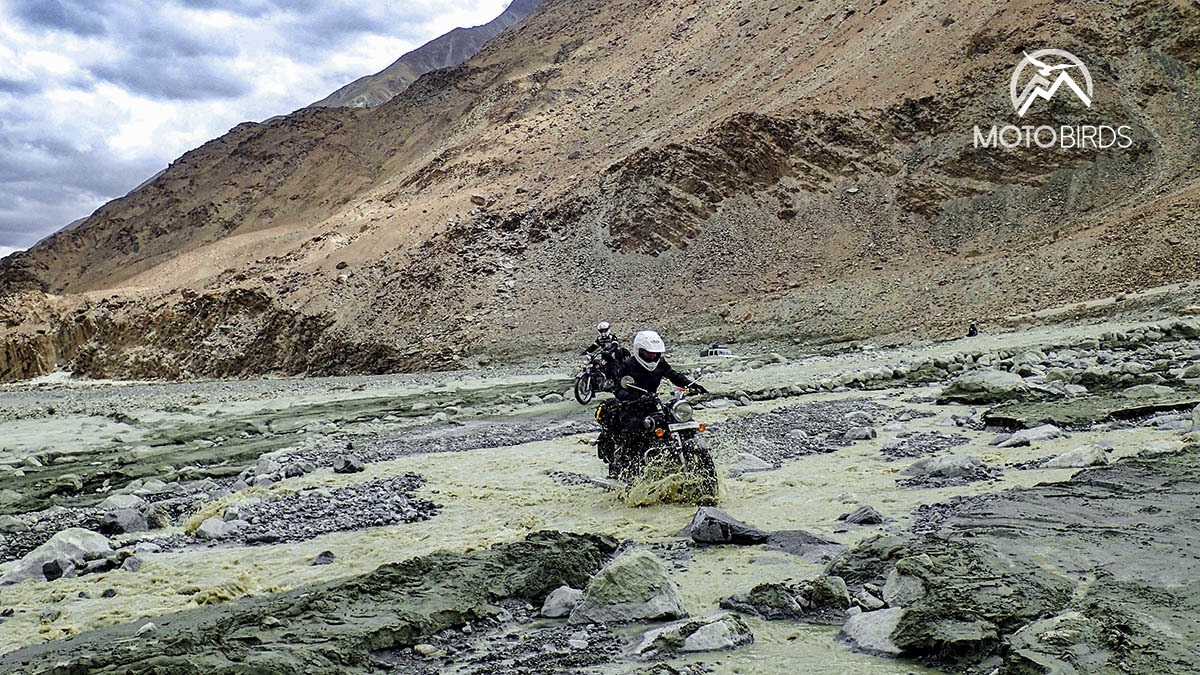
Fortunately, the team’s overcome so many challenges thus far: everyone’s quickly in position. We pushed, pulled and held the bikes so everyone can cross safely. The remaining few kilometers were blissfully uneventful and we made it to our hotel just in time for nightfall. Everybody was exhausted and could only think of a warm shower!
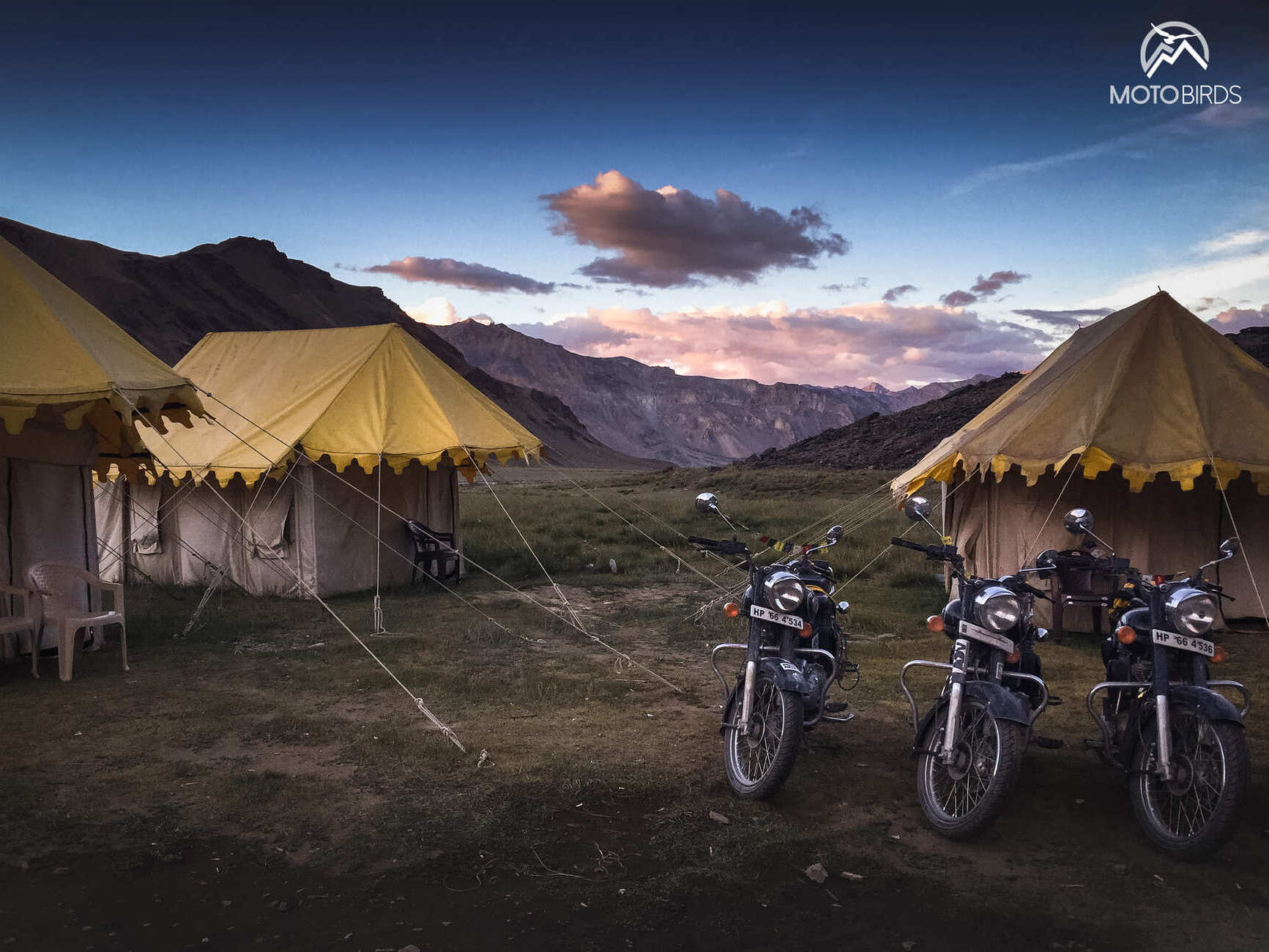

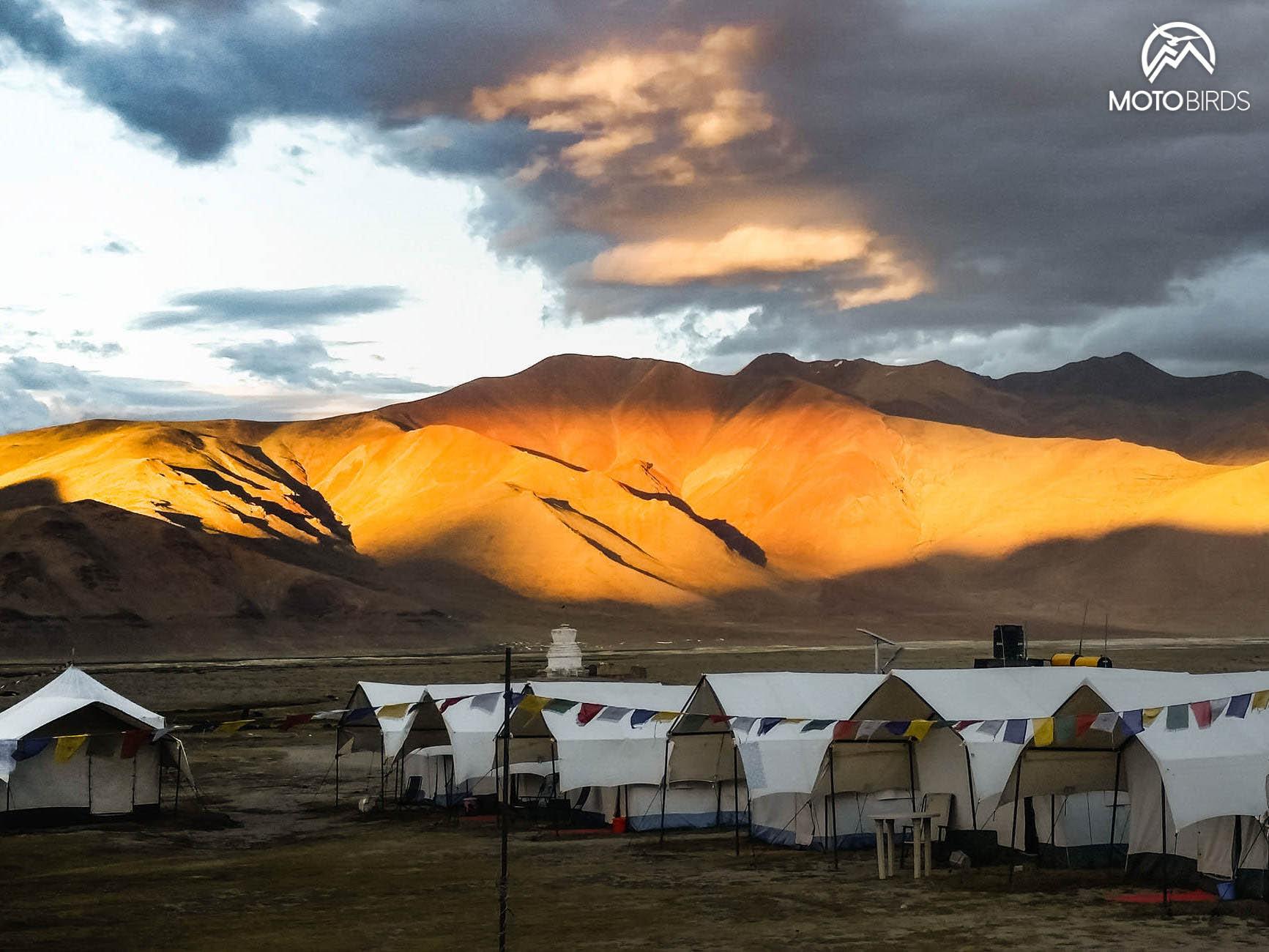
WHAT MATTERS MOST
Most days our accommodation was in tents. There are often no better option – and they are mostly more comfortable than guesthouses as well. The tents are prepared with normal beds, and even have a bathroom extension attached to them. This setup works actually very well in those high mountain conditions. Each biking day brought its lots of challenges, beautiful moments, companionship. Overcoming some high altitude passes (5602m) had taken a toll on everyone, in different ways. Each of us on this expedition had different motives for going on such women-only adventure ride. We all found something different, no doubt.
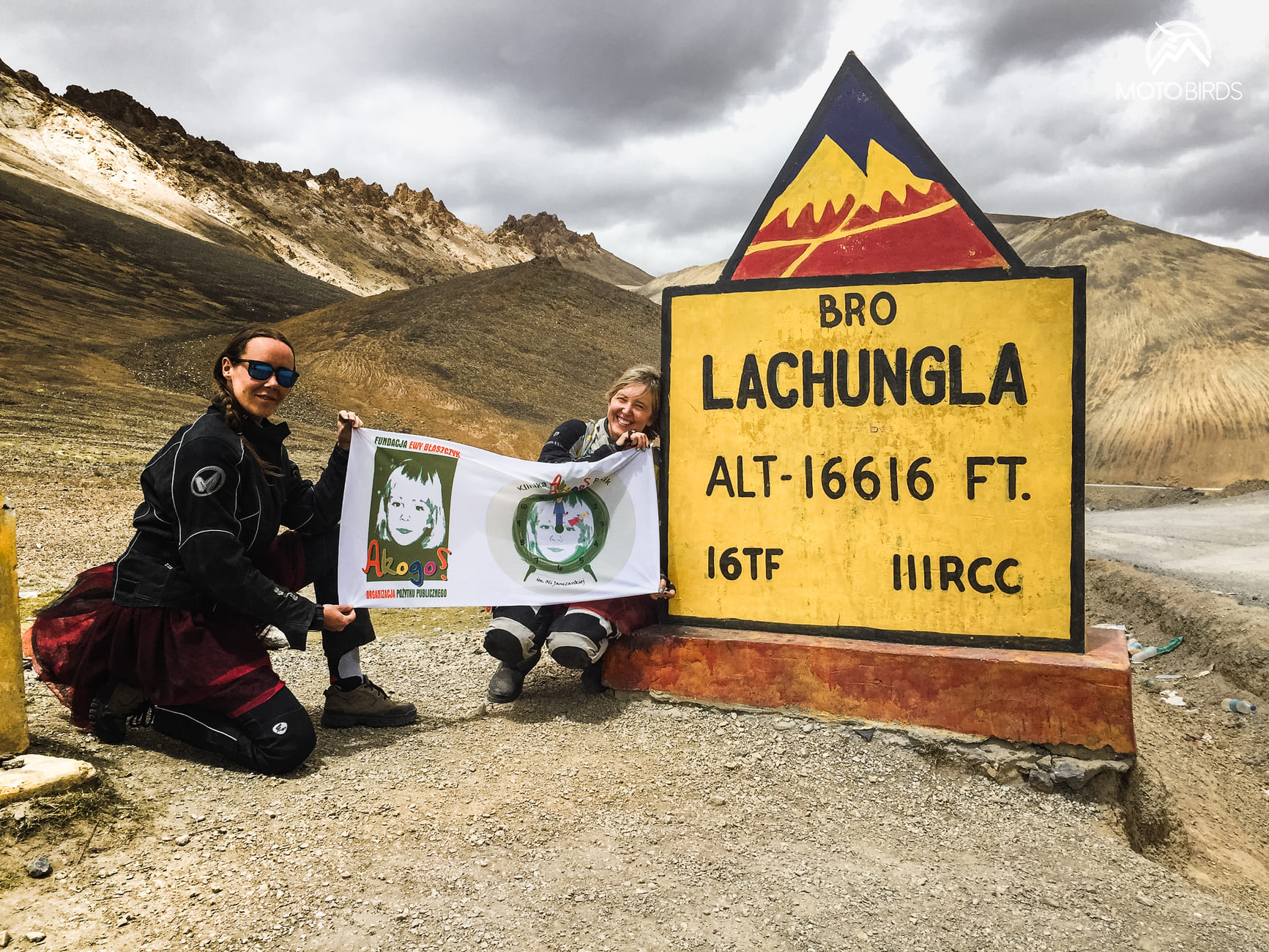
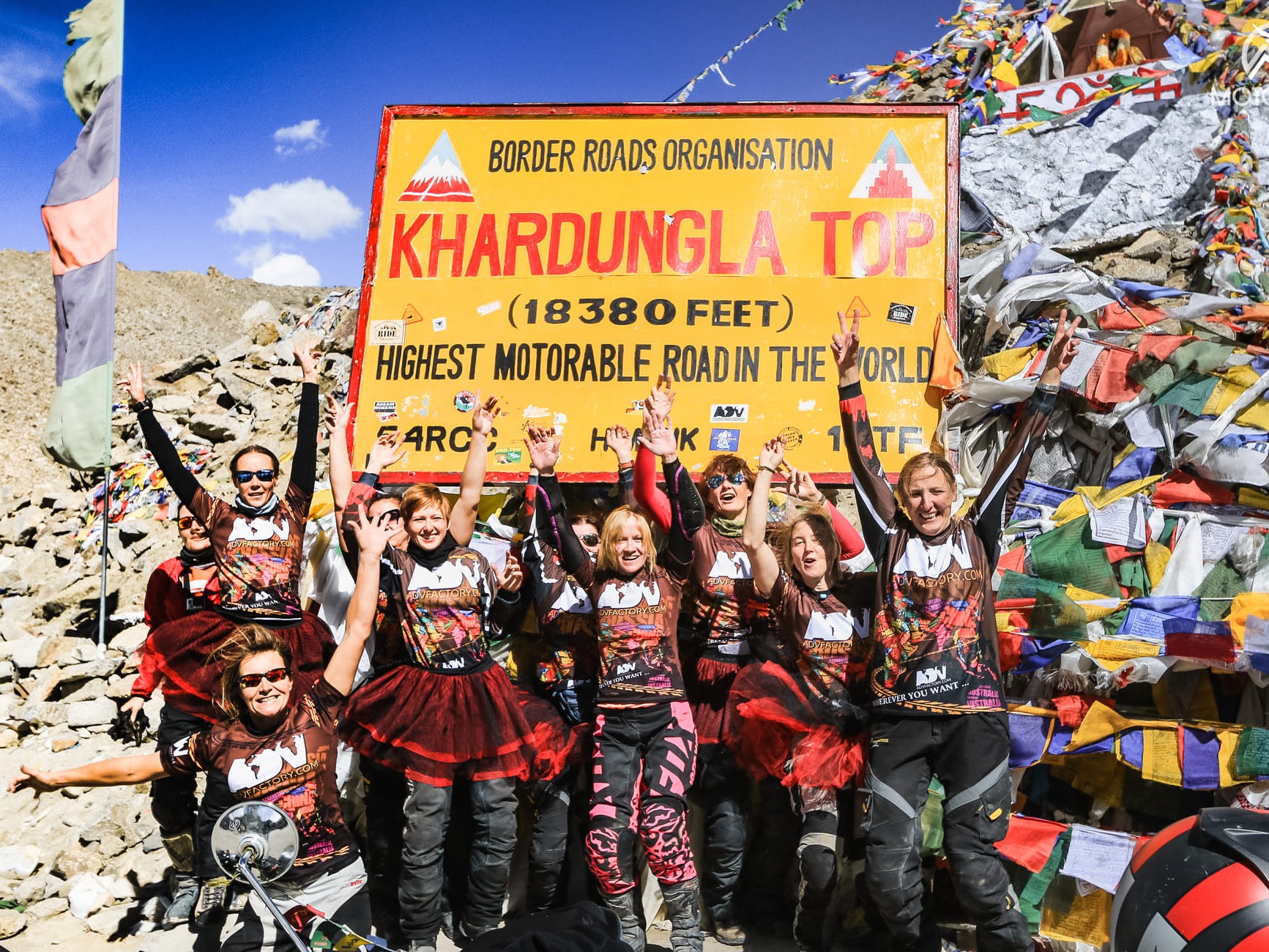
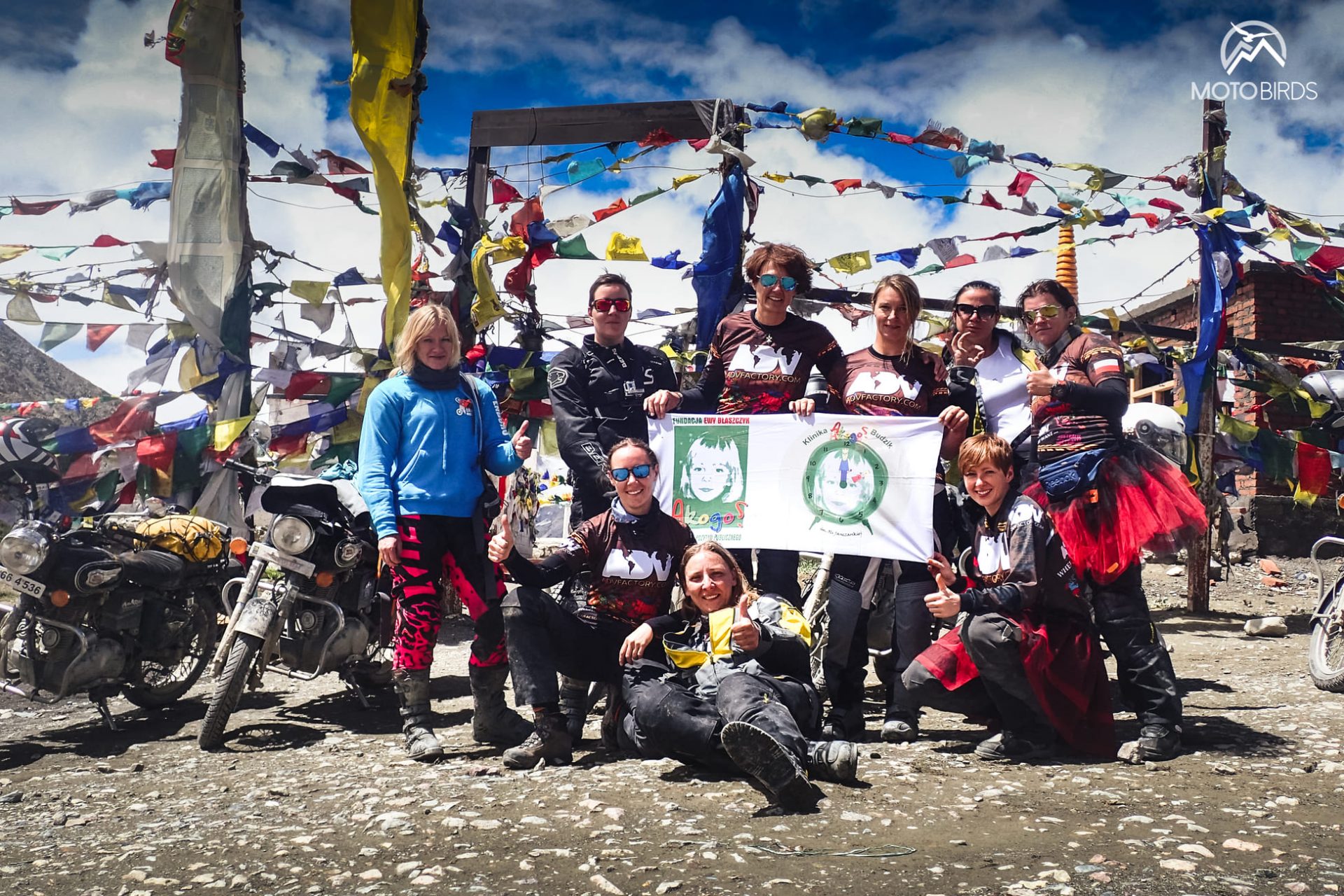

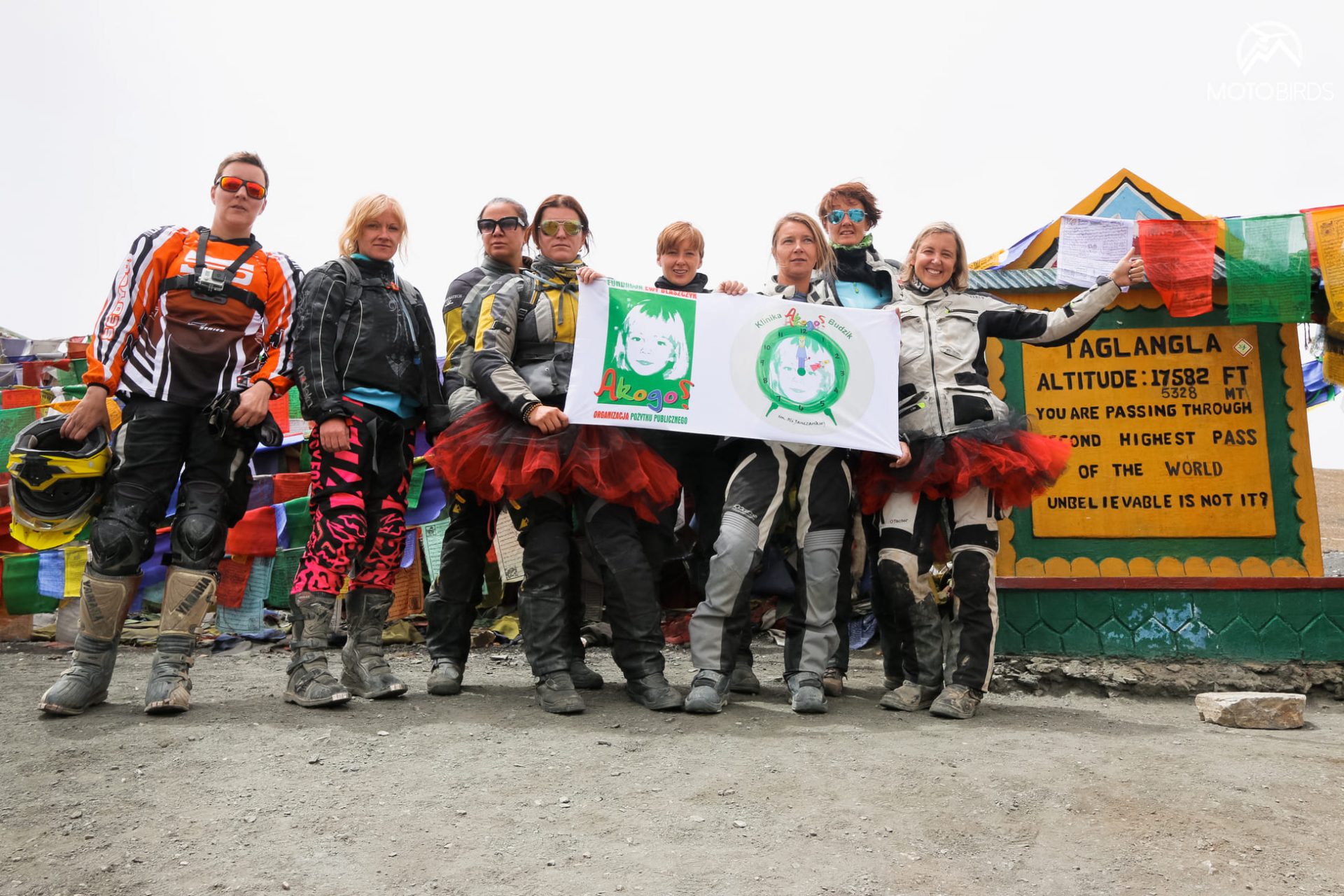
WAS IT WORTH IT?
The first “Women-Only” (PL: “Tylko dla Orlic”) tour in the Himalayas was probably the most unpredictable project I ever completed. I had a lot of expectations, but the project was also accompanied by many unknowns. A few years later, as I reflected on that expedition, I knew that somehow it had all been worth it: It was a beautiful, life-changing expedition. None of the dire warnings I had been given had turned out to be true. The team had surpassed itself, and each lady came out changed when they reached the other side.
The “Women-Only” project later went to Kyrgyzstan, Georgia, Sri Lanka, Argentina, Bolivia, Chile, Colombia and Costa Rica. In 2022, we’re finally headed back to the Himalayas and… we are also headed for the very first time to Africa!
We invite you to the Himalayas in August and September 2023 on 3 different tours! Ladies who want to travel in women-only company are welcome to join the tour within our “Women-Only” project. Women, men or couples who would love to get to know this beautiful part of the world in a mixed group can join one of the other tours.
WANT TO WATCH OUR AWARDED FILM FROM THE HIMALAYAS?
A fantastic 26-minute movie was made from our very first tour. Thanks to it, you can experience with us all the emotions and adventures described above. We would like to add immodestly that this work won an important award for us – 1st place at the “The Art of Ride. Motorcycle Film Festival”. We invite you to watch it HERE!
